

Huayna Potosi Climb: A Comprehensive Guide to the Summit
At 6,088m, the Huayna Potosi climb is a bucket list adventure for many travelers visiting Bolivia.
It’s known to be one of the easier 6,000m peaks to conquer, but do not be fooled.
Huayna Potosi is a beast!
I’m no stranger to altitude trekking, but I completely underestimated just how tough this climb would be.
After a 6-hour summit climb, I made it to the top and have shared all my tips and learnings in this guide to climbing Huayna Potosi in Bolivia.
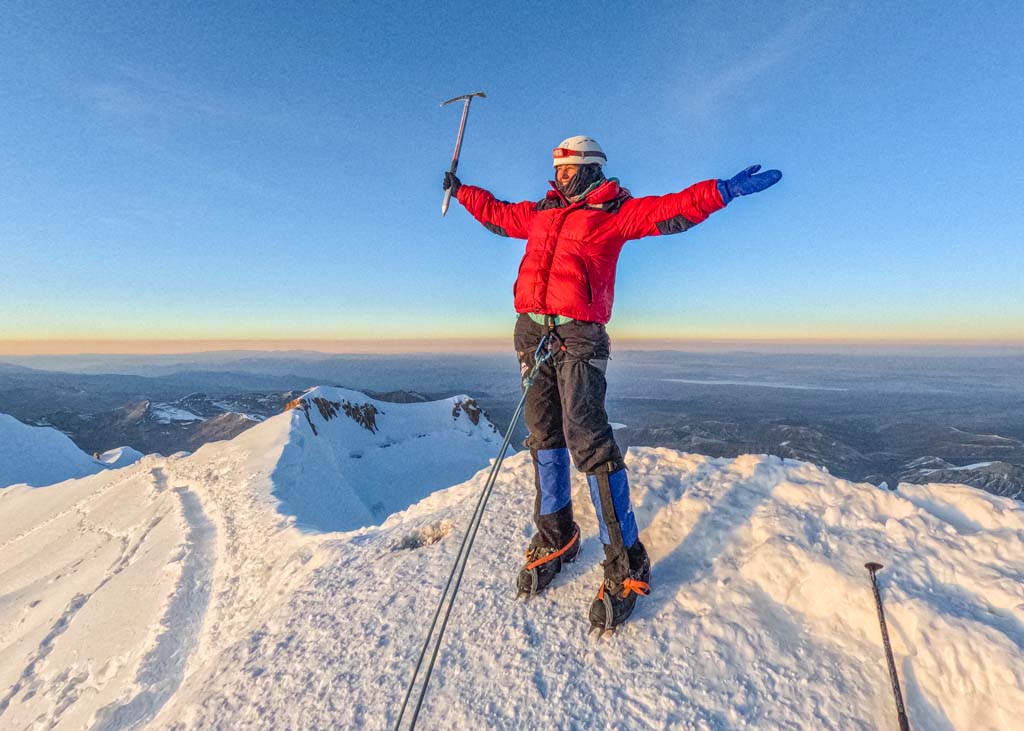
Quick Navigation
Huayna Potosi summary
- Summit height: 6,088m
- Days needed: 3
- Difficulty: Strenuous
- Costs: 850 – 1000 Bolivianos (Bs)
Where is Huayna Potosi
Huayna Potosi forms part of the Cordillera Real mountain range of Bolivia. The trailhead is only 25 km from the capital city, La Paz.
Its proximity to La Paz makes it a popular climb for backpackers and outdoor enthusiasts looking to summit their first 6,000m peak.
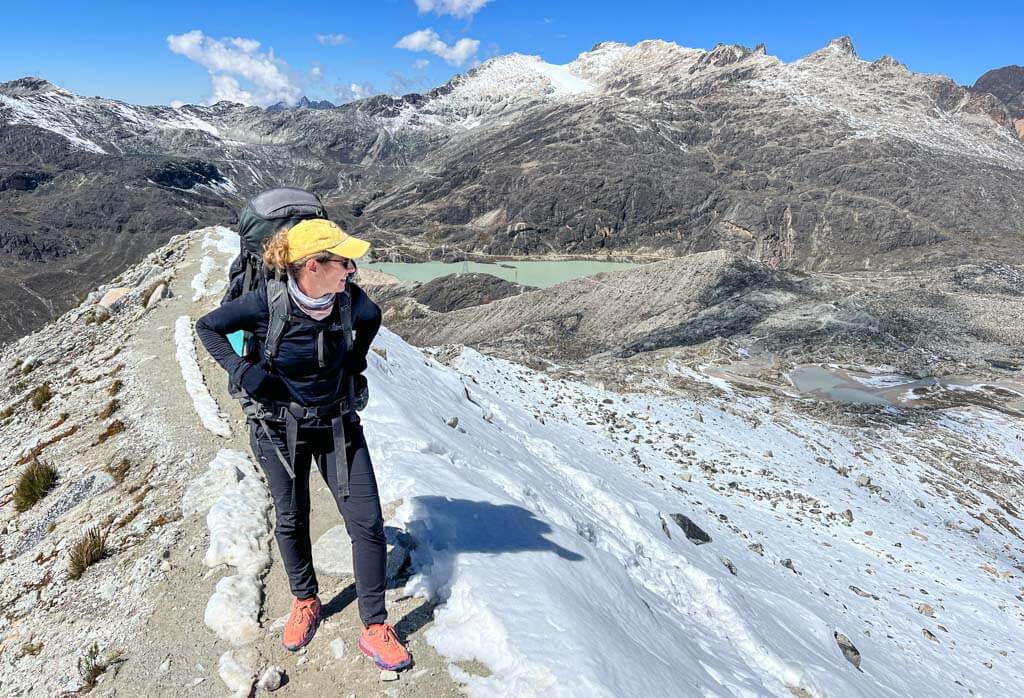
Best time to climb Huayna Potosi
The best time to climb Huayna Potosi is from May to September. This is the dry season and you can expect little to no rain and clear skies.
I successfully reached the summit in May and had perfect conditions.
However, it is still possible to climb Potosi all year round, but your chances of a successful summit are lower.
The climb during the wet season will be more challenging due to the wind, rain and snow, and the route may even be closed if the conditions are dangerous.
Huayna Potosi difficulty
Huayna Potosi has gained popularity amongst backpackers who arrive in Bolivia with very little training and preparation (as was the case with me) .
But don’t underestimate its difficulty!
It’s extremely tough, especially if it’s your first 6,000m peak.
While the route is ideal for novice mountaineers as it’s not overly technical, it still requires a good level of fitness.
The summit climb is extremely difficult, and you walk in snow the entire time. I thought it would be a gradual incline until the final stretch, but I was very wrong!
It is steep from the get-go and only gets steeper.
So, can people with no mountaineering experience take on Huayna Potosi? Yes! But do not think it’s going to be easy.
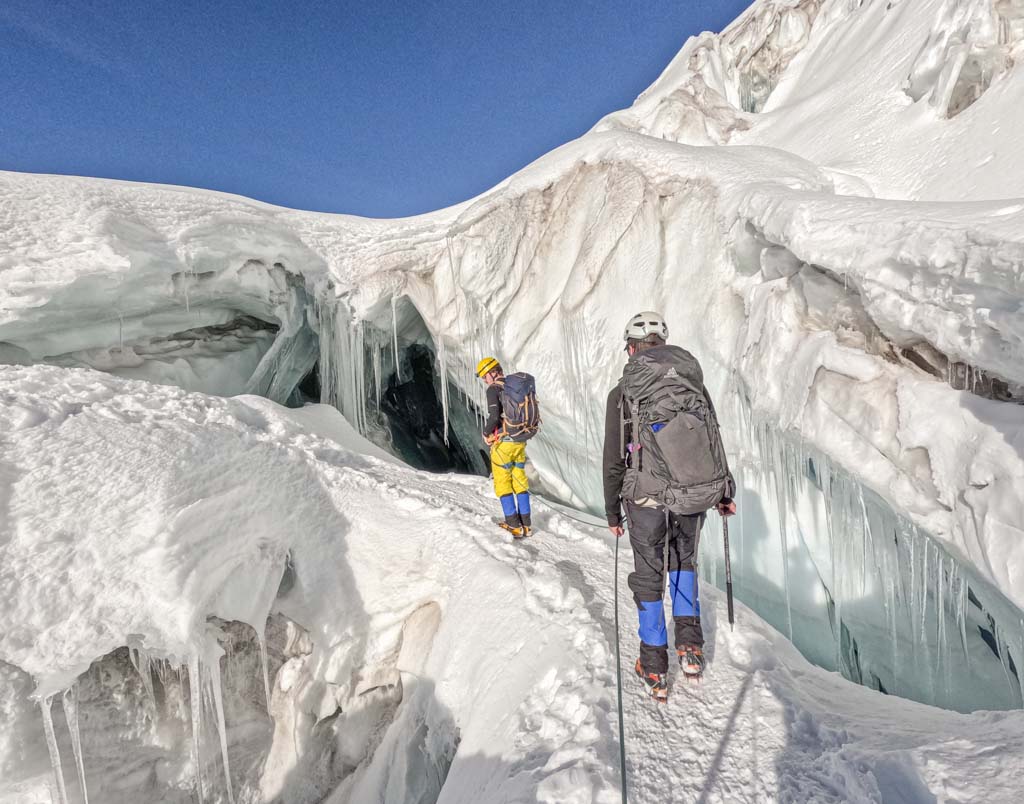
How many days does it take to climb Huayna Potosi
The standard Huayna Potosi climb is a 2-night/3-day tour from La Paz.
However, there is also a 2-day alternative. But I don’t recommend this.
Why? The high altitude.
If you’ve spent time acclimatizing at a higher altitude, have completed other altitude hikes, and are in top physical condition, then you could do the 2-day option.
But for everyone else, stick to the 3-day climb which will increase your chance of reaching the summit.
Costs to climb Huayna Potosi
Huayna Potosi tour costs are really affordable, considering it’s a 6,000m peak.
I paid 850 Bs (Bolivianos) for the 3-day tour with Illimani Mountain Tours. This included a guide, all climbing gear, a sleeping bag, return transport from La Paz, food, and accommodation.
There is an additional 50 Bs entry into the park.
I booked my tour two days before and found that all tour operators were similarly priced.
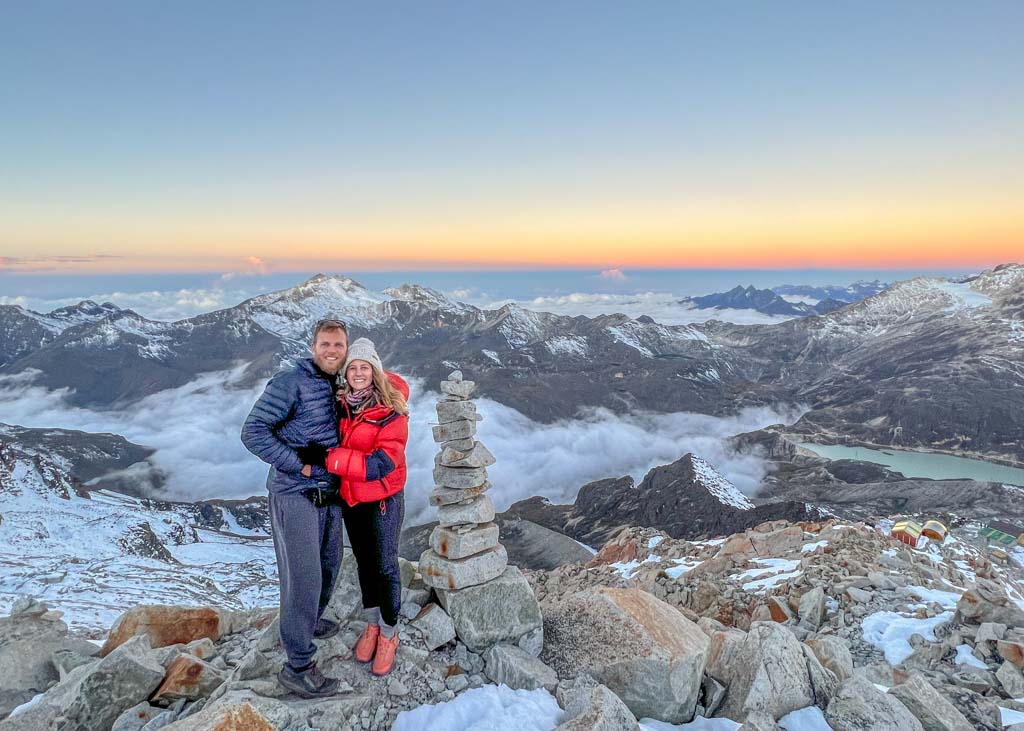
8 Things to know about the Huayna Potosi climb
1. the altitude.
Huayna Potosi is 6,088m above sea level. The altitude makes everything a struggle – breathing, sleeping, climbing, eating!
Being at altitude also makes the climb dangerous.
If you don’t acclimate properly, you can get Acute Mountain Sickness, which results from lower oxygen levels. Symptoms include headaches, nausea, vomiting, and loss of appetite.
AMS can be fatal if you don’t listen to your body and continue the trek despite being sick.
2. Spend at least three nights in La Paz
The best way for your body to acclimatize is by spending a few days at altitude before taking on a higher climb.
La Paz is at 3,640m, which is also pretty high. It’s the perfect place to spend your first few days in Bolivia before climbing Huayna Potosi.
I also recommend doing an acclimatization hike during this time. I climbed Austria Peak (5,350m), which is easily accessible on a day trip from La Paz.
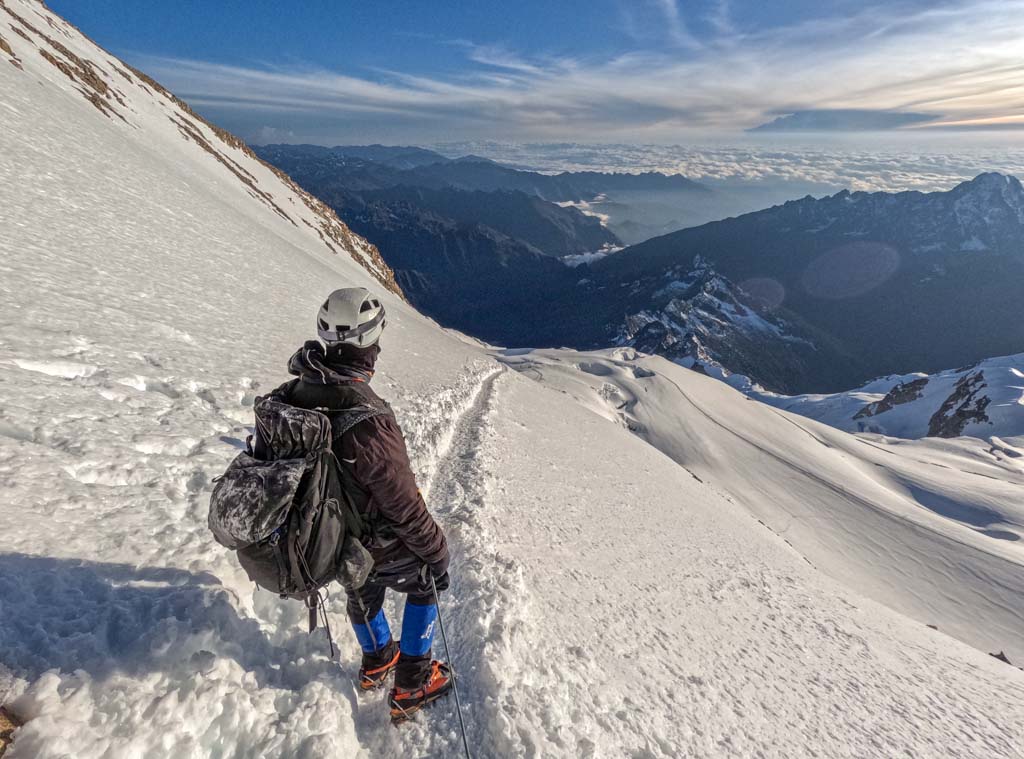
3. Accommodation during the climb
All accommodation for the Huayna Potosi climb is in rustic mountain huts. Most offer large dormitories with ten or more beds. Although the rooms are basic, they are comfortable.
A mattress will be waiting for you – but that’s about it. You’ll need to bring your own sleeping bag. It gets freezing cold overnight, so pack warmly.
There are no showers, but there are toilets.
4. There are two routes to the Huayna Potosi summit
Two routes lead to the summit of Huayna Potosi: the French Route and the Normal Route.
The most common route, and what I recommend, is the Normal Route. This is the easiest option and doesn’t involve any intense ice climbing. But it’s still tough!
The French Route is for experienced climbers only and involves some serious technical sections.
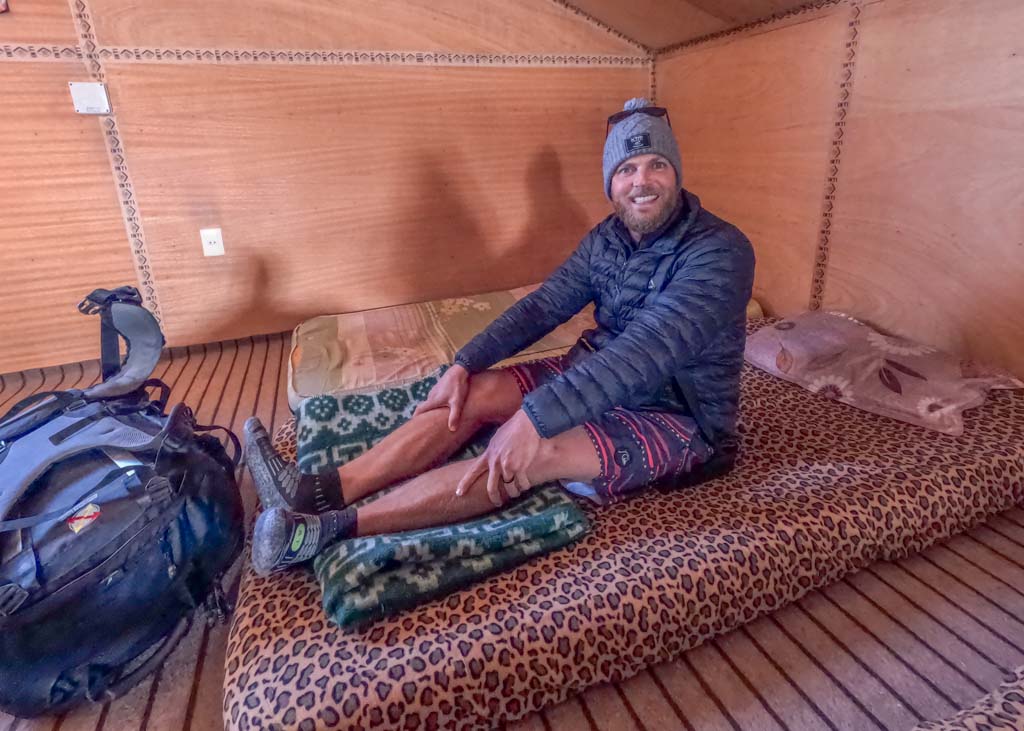
5. You need to reach the summit by 7 am
For safety reasons, you must reach Huayna Potosi’s summit by 7 am. The ice melts after sunrise, making the descent dangerous due to potential avalanches.
Walking at a slow pace is good for acclimatizing. But your guide could ask you to turn around if he doesn’t think you’ll make it by 7 am.
However, you don’t need to run up the mountain to meet the deadline!
I’m a slow hiker and was at my slowest during the Huayna Potosi climb. I reached the summit just in the nick of time!
6. There’s no ice wall at the summit
When I first saw images of people climbing Huayna Potosi, I assumed that the summit climb involved some pretty serious ice climbing.
But no, there is no ice climbing to reach the summit (unless you do the French Route).
So, why do photos show everyone climbing a massive ice wall?
This, as my mountain guide said, is for the “photo.”
As part of the technical training on day 1, you visit a glacier with an ice wall you can climb – if you want to.
It’s a fun activity, and you basically go up and back down again.
Note: You will use your ice axe during the summit climb. But this is more so for support rather than for actual climbing.
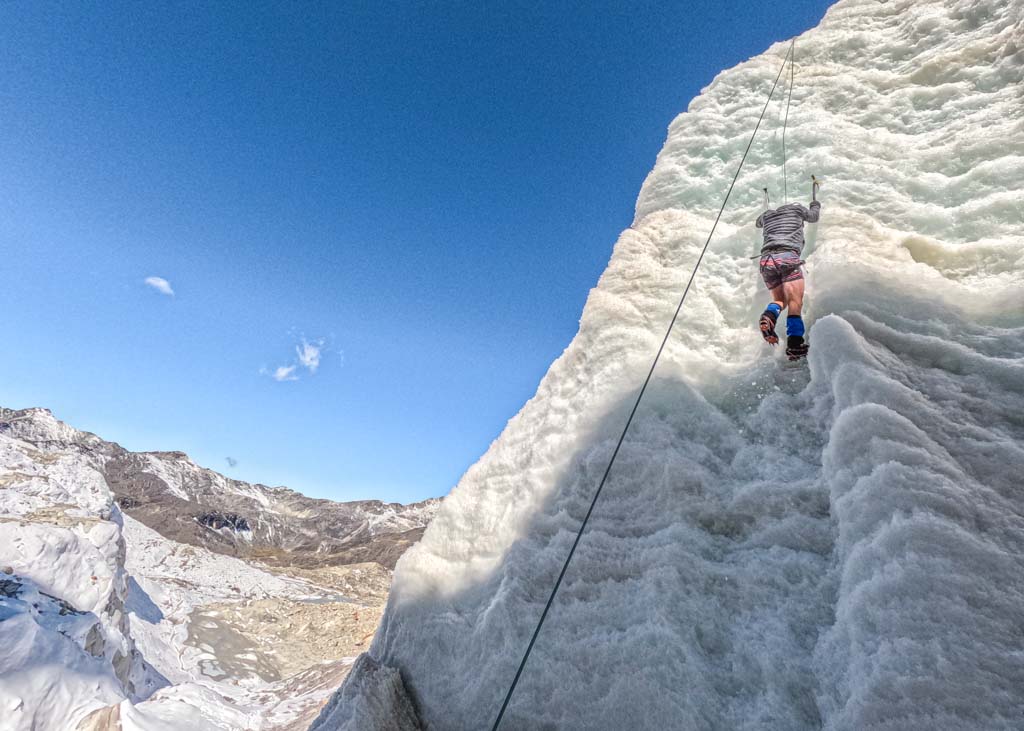
7. Huayna Potosi Deaths
As with all peak climbing, there are risks. There have been deaths on Huayna Potosi. However, it is very uncommon.
This is why you need to take the altitude seriously and acclimatize properly. Listen to your body and walk slowly. If you start experiencing throbbing headaches and nausea, turn around.
There are crevasses, and sections of the summit climb that can be dangerous, so you need to concentrate and watch your footing.
Your guides will put your safety first, so listen to their advice if they’re worried about weather conditions or your health. Don’t take any chances.
8. You can pay for a porter on day 2
On day 2, you must carry all your gear from Base Camp (4,700m) to High Camp (5,200m). This includes your ice boots, crampons, axes, helmet, and harness.
With all this extra weight, your pack will weigh about 17kg. This might be ok for regular treks, but when you’re climbing at altitude, 17kg is a lot.
The guys in my group seemed fine with the extra weight, but I really struggled (I was the only female).
It slowed me down quite a bit, and my body was exhausted when I made it to High Camp.
You can pay 150 Bs for a porter to carry your bag instead.
I was too stubborn and wanted to do it myself. But in hindsight, I should have saved my energy for the summit attempt.
Remember, you’ll start climbing to the summit on night 2. If your body is tired from a strenuous day getting to High Camp, it might affect your chances of reaching the top.
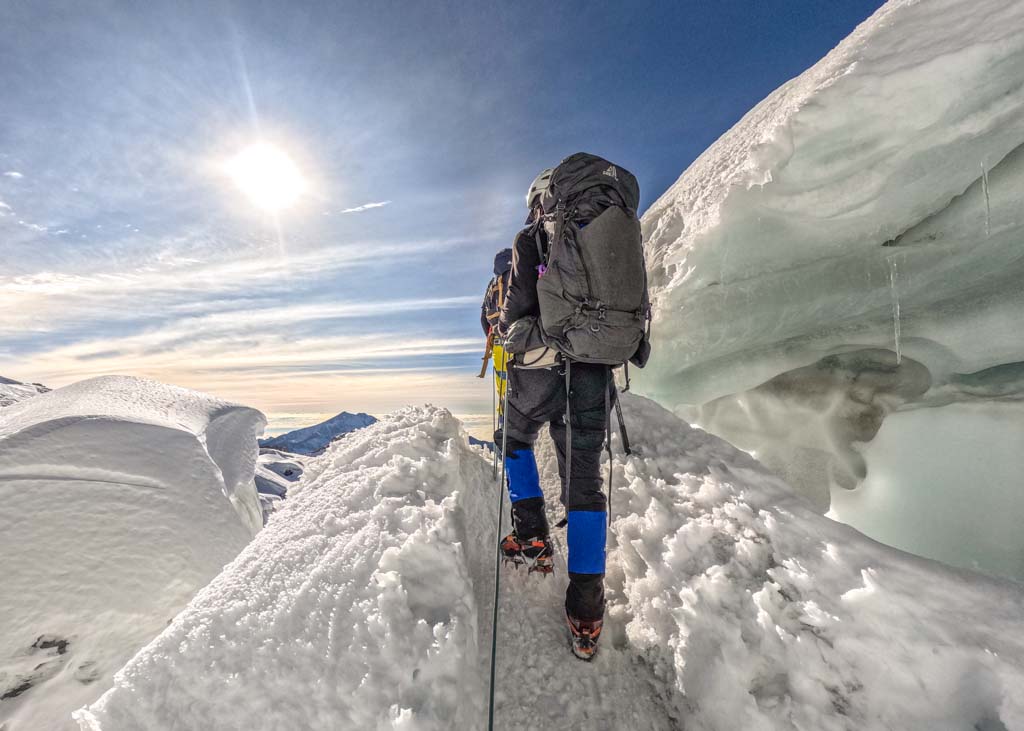
Huayna Potosi itinerary
Day 1: la paz – base camp (4,700m) – glacier training – base camp.
On day 1, you’ll leave La Paz at 9 am and drive to Huayna Potosi Base Camp, arriving by 11 am.
You’ll settle in, drop off your gear and have a quick lunch. In the afternoon, you’ll walk from Base Camp to a nearby glacier. Here, you’ll put on all your climbing gear and practice walking in your crampons.
Once you’re comfortable with the technical aspects, you can climb the ice wall. You’ll then make your way back down to Base Camp.
Day 1 is very relaxed compared to days 2 and 3. But it’s still an important day for acclimatization and touching up on your skills needed for the technical sections.
Note: If you’re doing the 2-day itinerary (not 3 days), you will skip this afternoon’s training. Instead, you will go straight to High Camp on day 1 and not spend the night at Base Camp.
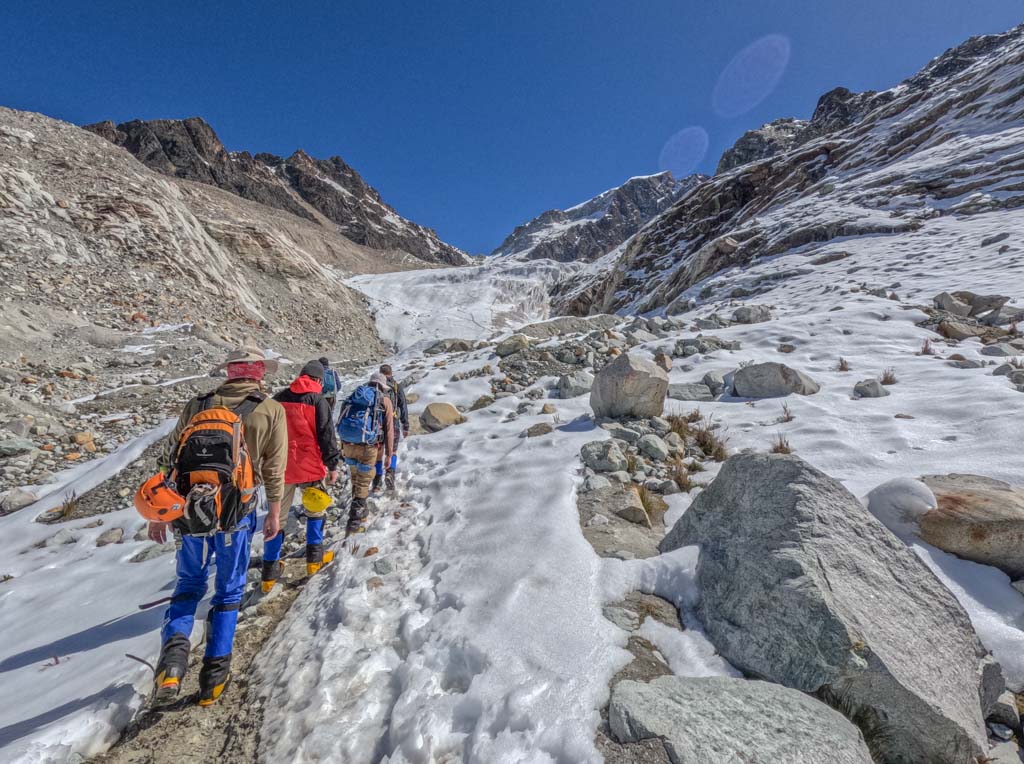
Day 2: Base Camp (4,700m)- High Camp (5,200m)
On day 2, you’ll climb from Huayna Potosi Base Camp to High Camp with all your gear.
This will take 3 to 4 hours. Some sections are in the snow, and the route has numerous switchbacks as it is very steep.
Day 3: High Camp (5,200m) – Huayna Potosi Summit (6,088m) – Base Camp – La Paz
Day 3 is the most challenging: the summit climb.
You’ll start your trek at 1 am and continue for 6 hours to the summit. Your harness will be attached to your guide and climbing buddy for safety reasons. The first 5 hours are in the dark. But at least you won’t see what’s coming!
The final stretch to the summit is the most intense, but no hectic technical climbing is involved.
After spending 15 minutes taking in the views, you’ll start your descent to Base Camp. This is when you’ll realize just how steep the climb was.
It will take 3 to 4 hours to get down, making it a 10-hour trekking day!
A colectivo bus will be waiting for you at Base Camp, and you’ll be back in La Paz by 6 pm.
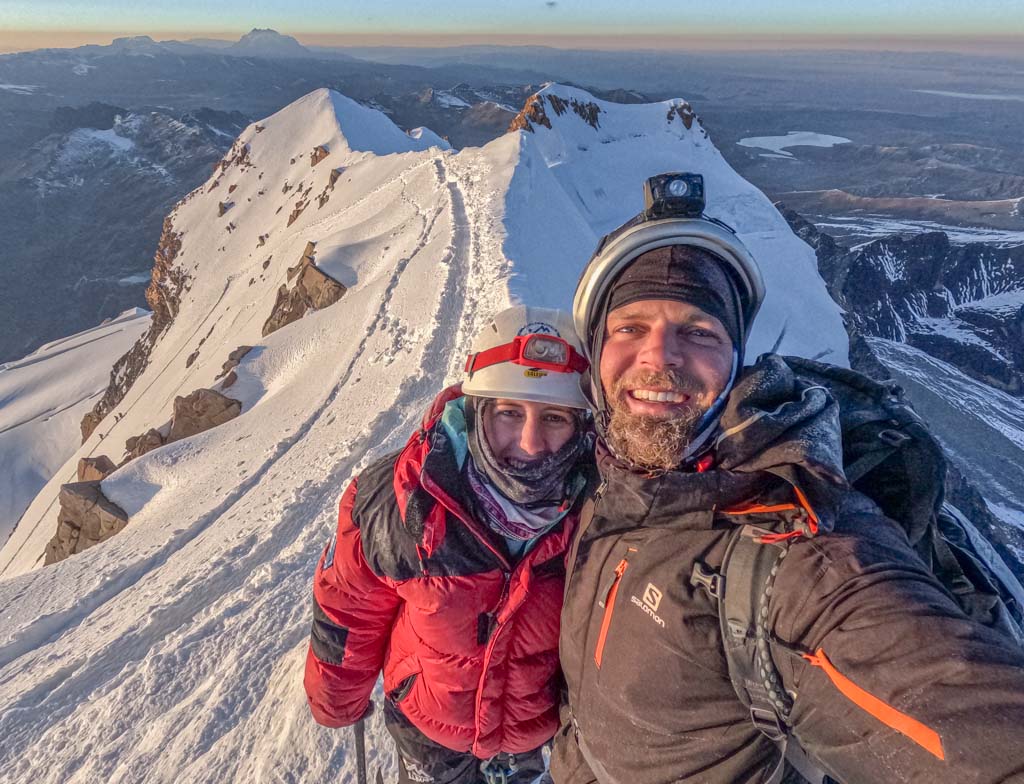
What to pack
- 50 l backpack
- 2 hiking tops
- 2 hiking pants
- 1 set of thermal underwear
- Fleece jacket
- 2 pairs of thick socks
- Water bottles (2l)
- Toilet paper
- Hiking/trail shoes
Provided by your tour operator
- Sleeping bag (-10 degrees)
- Down jacket
- Waterproof pants
- Trekking poles
My experience of climbing Huayna Potosi
When I think of Huayna Potosi, the summit climb is the first thing that comes to mind!
After 4 hours of trekking uphill in the snow, I didn’t think I would make it to the summit.
My body was exhausted, my legs were heavy, and I struggled to catch my breath. But I had no headache and no symptoms of altitude sickness.
I knew that I had it in me to get to the summit. I also knew I would never live it down if I failed because “my legs were sore.”
So I kept going and finally made it. It was a mental struggle more than anything else.
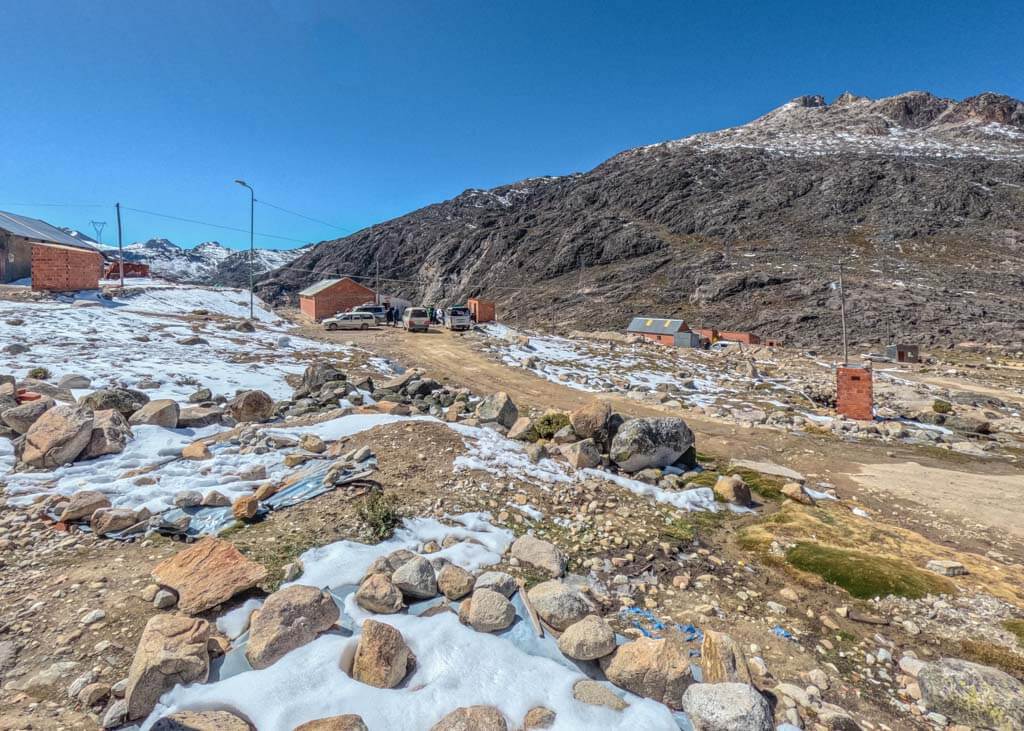
Is Huayna Potosi Worth it
Before climbing Huayna Potosi, I spent weeks deciding whether to do it. I had already summited a 6,000m peak in Nepal and knew what was in store.
Did I really want to put myself through 3 days of torture to get to the summit of Huayna Potosi?
Well, I’m so glad I did!
The views throughout the trek are spectacular. But the climb was about more than that.
It was saying yes to a massive challenge. Pushing myself to my limits both mentally and physically. Meeting travelers from all over the world who were experiencing the same struggles I was. Supporting each other. Encouraging each other.
No, I did not love climbing Huayna Potosi. In fact, I hated it! But it was the most memorable thing I did during my 7-month backpacking trip.
Where to next
After my Huayna Potosi trek, I headed north to the Bolivian Amazon . It was just what I needed – sea level and warmer weather!
If you have time, I highly recommend you do the same.
Like it? Pin it!
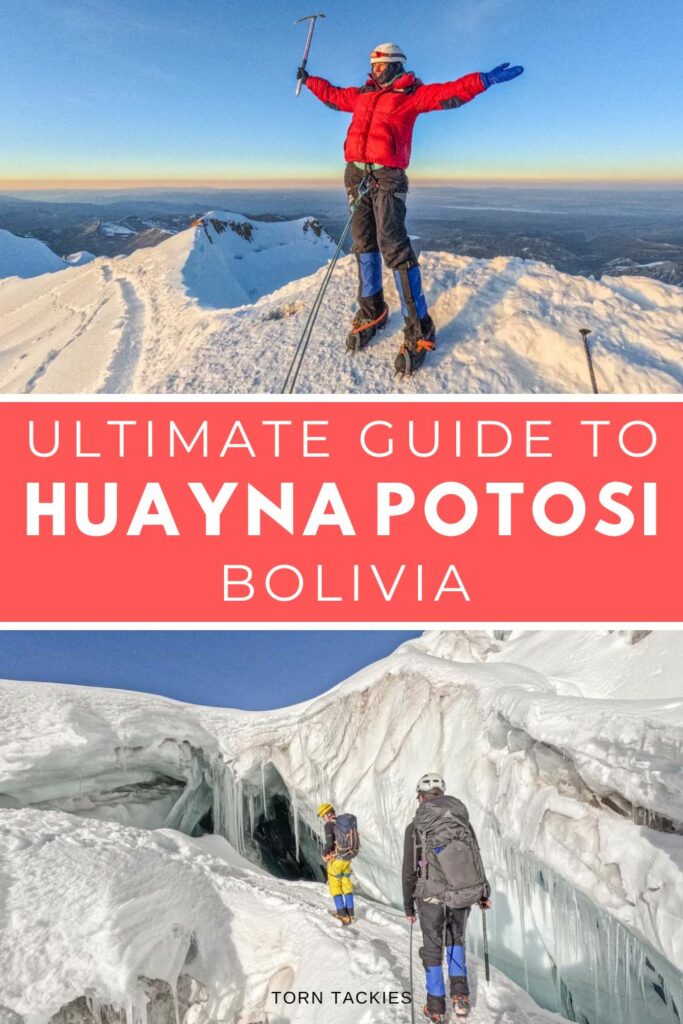
Are you planning on climbing Huayna Potosi in Bolivia? Drop me a message in the comments section below if you have any questions.
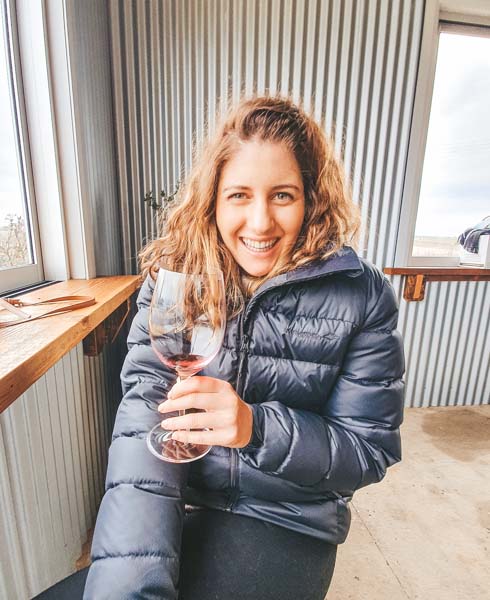
Hi, I'm Carryn. I’m an adventure travel blogger trying to figure out my way through life by traveling and exploring. Join me as I share my travel guides and tips for life abroad. Find out more about me here .
Salkantay Trek Difficulty: 12 Important Things You Need To Know
27 things i wish i knew before doing the w trek self guided tour [2024], 4 thoughts on “huayna potosi climb: a comprehensive guide to the summit”.
Great blog! Thank you for all the info. Do you have the name of the company you used? Thank you Max and Jacqueline
Hi Max and Jacqueline,
I booked my Huayna Potosi climb with Illimani Mountain Tours. Their office is on the main street where you’ll find all the tour operators. I chose them as a few hikers we met while climbing Pico Austria had organised a small group tour and we decided to join them. We were only 6 in our group which I prefer over bigger tours. Jiwaki also comes highly recommended.
Good luck and enjoy!
Hey Carryn,
I was wondering how often you get to take a break on the last day to the summit? I normally walk fast for 15 minutes but then take a longer break compared to walking 30 minutes slower and a shorter break. I’m just a bit nervous because of the 7 am deadline. Hope you can reassure me a bit.
I also see you are wearing a backpack during the descent from the summit. How heavy was the bag? It’s not the 17kg like on day 2 is it?
Kind regards
Have you done any high altitude climbing before? You’ll be walking very very slowly to the summmit – at a snails pace! This is to help your body acclimatize. I don’t recommend walking fast, and neither will your guide. The entire way is a gradual incline and it’s freezing cold, so you won’t want to stop for very long. You do have time to rest (have some water, and a small snack) but you shouldn’t stop for more than 5 minutes – not because of the time, but because you will get too cold and loose momentum.
Don’t worry about the 7am deadline – your focus should be getting one foot in front of the other. I walked slower than anyone and was the last person to arrive at the summit, but I still managed to get there by 7 am. So you’ll be good :).
Regarding the bag, you will need to carry a small backpack to the summit that will have your water, snacks and maybe an additional top layer. I didn’t have a small bag so used the big backpack that used on days 1 and 2. I left all my clothes and gear at high camp, and so the bag might seem big, but it only have water and snacks.
Good luck with your climb.
Leave a Comment Cancel reply

Zen Travellers
Two round the world travellers and our guide for adding a little zen to your adventures. Travel advice, stories, and inspiration!

Hiking in Bolivia: The Cordillera Real to Huayna Potosi
Bolivia’s Cordillera Real (or royal range) is an unrivalled destination for trekking in South America and exploring this mountain range is one of the best things to do in Bolivia. We spent 8 days hiking in Bolivia and finished our trek by climbing Huayna Potosi
The 125km Andean mountain range rises to the southeast of Lake Titicaca and some of its glaciated peaks can be seen from Bolivia’s exciting capital La Paz . If you’re looking for some high altitude fun without the crowds seen in other parts of South America, the Cordillera Real are for you.
While there are options ranging from a day hike to the full 17-20 day TransCordillera trek, we booked a guided 8 day trek through the range that cumulated with summiting Huayna Potosi at 6088m (19,9974 feet) with a local tour operator. It was one of our most memorable experiences so far during our 14 month trip around the world . Having hiked extensively in Peru in Huaraz , completing the Salkantay Trek to Machu Picchu , and exploring Colca Canyon , we were primed for a longer backpacking trip and to attempt to reach our highest elevation yet. The Cordillera Real delivered not only breathtakingly beautiful views, but also afforded us a degree of solitude not experienced elsewhere during our six months in South America. For many days on the trail, it was just us our guide, and maybe the occasional llama farmer. Bliss.

All that said, we still had a number of questions that we asked before starting the trek which we’ll answer here so you can plan your own memorable trip!
Tour or DIY?
The first thing we asked ourselves was whether to hike the Cordillera Real guided or DIY. We had originally planned to hike the Colorado Trail in August and Septmember which would have been a fully self-supported adventure, but fires had closed portions of the trail and we were reluctant to leave South America since we had been enjoying ourselves so much. Despite having our hearts set on doing some thru-hiking, we opted to stay in South America and extend our time in Bolivia. It’s such an incredible place and we’re really glad we stayed.
That said, we wondered if we could make up the thru-hiking experience with a self-supported TransCordillera trek. We had read about a few people doing it and though we might be up to the challenge. One of the groups did it entirely on their own, and the other carried their own food and gear but paid for a local guide. Our initial research put the cost of a fully guided TransCordillera hike at about $1200-2500usd+ per person which was way out of our price range.
Curious to learn more about a DIY trek, we spoke with Jeff from Climbing South America . His agency would be able to rent us the gear we needed for about $30usd, maps for about 30bs each, and they even had some dehydrated meals they could sell us that would help keep our food weight down. He spent a lot of time going over the route with us in detail which was extremely helpful.
The old route, or east side, is currently being bisected by mining roads and increased industrial activity so Climbing South America prefers to guide people along the west route since it’s more tranquil and less developed. That said, the west route is requires difficult route-finding in some parts, being little more than a llama trail and dangerous in the sense that a wrong turn could lead you up to an impassable cliff.

If we wanted to carry our own gear and be guided, it would cost about $70 usd per day, still have to purchase our food, and pay for the guide’s food as well.
With the DIY option, we would have to arrange our own transportation to and from the trail, which could be anywhere from a few dollars on a public bus to over $100usd for a private hire. So a fully DIY version would cost us at least $600usd plus food for a TransCordillera trek without a Potosi summit. Adding a guided summit, which we felt was necessary since we don’t have a lot of mountaineering experience our own ropes/harnesses etc would cost an additional $150-300usd per person for a 3 day trek depending on which agency we went with. While the price of a DIY trek was appealing, we were fairly intimidated by doing the first couple days of the route where it’s very easy to lose the trail.
Mulling all that over, we went and spoke to some local agencies to see what their prices were like. Local agencies tend to cost a lot less than ones with English websites that are owned and/or operated by non-nationals. Often, their gear might not be as shiny and new and the food provided will be very basic, but they’re still generally a great option for more budget-minded travellers. Also, the guides will likely only speak Spanish so if you don’t know any Spanish at all, you may need to pay more for an English-speaking guide. The quotes some local agencies gave us for a fully-guided 14 day TransCordillera hike with a Potosi Summit were about $2000 USD for the two of us.

We still felt like that might be too much of a budget buster for us at this price point but the fully DIY version intimidated us with the difficult route-finding, so we opted in the end to do a shorter, guided version with Mountain Guide Juan Alaña’s agency in the La Paz center. We would hike for 5 days in the Cordillera Real beginning at Laguna Khotia before joining the standard 3 day Huayana Potosi summit trip. This was a great way to explore some of the Cordillera Real and ensure that we would be both strong and acclimated for the big summit day.
Juan set us up with equipment, warm clothes for the glacier portion, a Spanish-speaking Mountaineering Guide who is his younger brother Ronald, a porter for portions of the trail, transportation, all food for meals, and bookings at refugios for 6000Bs/$865usd for the two of us. Snacks and tips would be optional extras.
Given the huge discrepancies in prices between agencies, we asked Jeff what exactly do you get for thousands of dollars more? His take on it was perhaps most importantly for some people, an English-speaking guide, access to nicer refugios (more on the refugios later…) or a high quality tent, and much better food. For us, we eat well enough when we’re not hiking that we felt like a couple days of rice and pasta wouldn’t kill us and our Spanish is good enough to get by most days, so we went for the less expensive option.
What is Trekking the Cordillera Real like?
The trek from Laguna Khotia (4750m) to Huayana Potosi base camp is a pretty magical one. Throughout the trek there are beautiful alpine lakes, sweeping views from the high passes, and chances to see bird life and more llamas and alpacas than you’d ever thought you’d see in your lifetime. On the first day, Lake Titicaca appears off in the distance, as does El Alto from Pico Austria at 5300m. Your objective Huayana Potosi begins as a distant peak before dominating the horizon as you continue to walk closer.

For almost the entire trek, we had the trail to ourselves and only ran into other hikers on the 3rd day when we summited Pico Austria, which is a popular day hike from La Paz.

On the 4th day, we met a local llama farmer who looked more at home on the mountainside than us in her traditional chola skirt and alpaca wool sweater. She spun a top of alpaca yarn as she chatted with us and enjoyed a good laugh when I tried and failed at keeping it spinning.
The elevation along the trail rarely dips below 4500m, so be sure to be well acclimated beforehand but otherwise it mostly just gently rolls along high-elevation passes rarely gaining more than 600m in a day. Most days we hiked between 4-7 hours to reach the next refugio.
On the 6th day, you must carry your own bag from the refugio to Huayna Potosi basecamp for about 4 hours.

As for going with the local agency, we were very glad we did. My mountaineering boots were a bit sad, but otherwise everything worked well and Ronald was an excellent guide. He was very knowledgeable and made our safety a priority. He was also our chef and prepared a simple but good hot lunch and dinner for us every day. He worked very hard to say the least!
Staying in Refugios vs Tents
The average elevation where we camped was around 4800m, so pretty darned high. Temperatures were around zero Celsius (32f) at night so packing warm clothes, gloves, and a toque/beanie are essential. The refugios along the trail were very rustic, and not in like the charming cabin in the woods way. We’re talking dirt floors, broken windows, uninsulated walls, and just generally unfinished and at times, not very clean. The “beds” in them are frequently nothing but straw packed into a plastic covering and set on the floor. I can’t do straw mats on the floor so I brought my trusty Therma-rest Neo-Air and saved my back.
We had to chuckle to ourselves a bit because Ronald kept promising us that “the next one would be better” at every single refugio. That didn’t end up being true until we arrived at Huayna Potosi where the refugios are nice and warm, and the mattresses are plush.

Ironically, the worst refugio was the one from the first night where it looked modern and nice from the outside, but was unfinished and uncared for on the inside. Each room had a bathroom and the beginnings of a shower as well as electric plug ins, so if it was finished it would be a really nice place to stay. Instead, it was filthy with the bathroom overflowing with garbage and the room where we slept had mouse droppings in the corner.
It’s important to remember that Bolivia is still a developing country and you can’t expect the same degree of infrastructure that you might find in other parts of the world. It’s also important to remember that this is a backcountry area so you should expect services to be limited and also make an effort not to bring a lot of garbage with you and adhere to Leave No Trace principals.
Were we to hike it again, we can’t help but feel like a tent and a high quality sleeping bag may be more comfortable than staying in some of those refugios. Just like in Huaraz, we’d like to come back with our own gear.
Best time to Hike in the Cordillera Real
The hiking season in the Cordillera Real is generally April to October. We hiked at the end of August and the weather was perfect – mostly sunny days, no rain, and cooler nights. That said, we met a couple who had tried to do some hiking only a couple weeks after us and were told that it was too snowy and they weren’t leading trips, so it’s very weather dependent.
Climbing Huayna Potosi
There is a varying range of reports on the difficulty of climbing Huayna Potosi. Some places refer to it as the “easiest 6000m mountain in the world”, other people write as if the entire journey was lifethreatening and they are the most badass daredevils for even trying it. The truth to us, is somewhere in the middle. There are no doubt, serious risks involved in climbing Potosi, as glacier travel is always more complicated than straightforward trekking but as far as high altitude climbing goes, this is a pretty simple summit.

Acute Mountain Sickness , or altitude sickness, is a risk here and the only cure if it’s a serious case is to descend. Coca leaves can help relieve the headache and give you some energy. To that end, we carried a thermos of coca leaf tea during our summit attempt, but they do not cure altitude sickness despite what you may hear people say. If your condition is worsening as you climb, you have to go down. It can be fatal to keep climbing. Talk to your guide and you may be able to spend an extra night at High Camp and try again once you’re more acclimatised for an additional fee.
There are small crevasses to navigate but nothing too serious. For the most part, as long as you’re wearing crampons and roped in, you should make it up the popular route without issues. Most fatalities on the mountain occur on the French route when people are climbing unguided.
We passed a lot of people along the way and many didn’t end up making it to the top. The most technical part of the climb involves moving across some rocks on a steeper part of the mountain. I had very old, not very well-fitting mountaineering boots on and slipped a little on this part but Ronald tightened the ropes pretty much immediately and I was fine.

After that, it’s the corniced ridge that could be dangerous. The path to the top cuts much below it but I could see an unexperienced person getting too close to it. Once on the summit, our guide and only one other drilled a bolt into the rock and clipped us to it. Many other people were walking around on the small summit without that added protection from falling. You would have to be pretty careless to fall, but we have all heard of those people, experienced or not, who have fallen to their deaths for a selfie.
Getting to the Summit of Huayna Potosi
If you are simply doing the 3 day trek to Huayna Potosi from La Paz, you will drive to base camp at 4750m.
Once at base camp, you have the option of relaxing or hiking up to a nearby glacier to try out the equipment and give ice-climbing a shot. You won’t need to ice-climb to reach the summit so it’s purely just for fun, but we do recommend at least trying on the crampons and getting used to walking with the ice axe and ropes.

For 2nd (or 7th) day, you take an easy stroll from base camp to high camp at around 5200m. I say around because there are a few refugios between 5100m and 5300m and where you stay will depend on which one your agency works with. The trail was pretty straight forward until the ranger hut where it starts to climb a bit more steadily and lose rocks and snow make the trip more challenging. This year in particular had been very snowy in the Cordillera Real which made some of the higher parts of the trail snow-covered. Keep in mind that if it’s raining in La Paz, it will likely be raining on Potosi. Snowfalls of more than 15cm may complicate trip plans by causing avalanche danger.
If you do the two day trek, you will go straight to the high camp on day one and then try the summit on day two. Most of the failed trips we heard about were on the two day trips so it’s likely worth doing the three day unless you are confident that you are fully acclimated.

On the 3rd day (our 8th), we woke up at 12:30am, had a small snack and then headed out for the glacier. Poor Ronald struggled with my crampons for about 20 minutes so we didn’t end up leaving until closer to 2am. This complicated his plans to get us to the summit for sunrise. Nevertheless, we walked a slow and steady pace and made it to the summit just shy of 6:30am, in good time for sunrise. As for the walk, it wasn’t as challenging as we thought it would be but I think a lot of that had to do with us being well acclimated and in shape from having hiked so much in the days and months prior.
After watching the sunrise over the surrounding peaks and taking our share of the obligatory summit pictures, we started heading down which can be one of the most dangerous parts of the journey since you’ll be tired from the hike up. We took almost as long to get back down to High Camp as we did to get up. As soon as the sun comes up, it gets really hot on the glacier too so make sure you pack sunscreen and sun glasses. Keep the sunscreen in an inside pocket as mine was frozen solid when I went to use it and I had to wait for it to reheat in my pocket before I could put it on.
Once at High Camp, we had a second breakfast of a nice warm soup and tea before continuing on to Base Camp.
The hike down to Base Camp proved challenging again at times because of all the mixed rock and snow and I ended up breaking one of Juan’s crampons as well as one of my trekking poles. Nevertheless, we made it in decent time and enjoyed a well-deserved Paceña beer with Ronald. From there, we drove back to La Paz and enjoyed a delicious meal at the Steakhouse .

Packing for a Trek in the Cordillera Real
Here’s some things we brought to stay comfortable on the trek. We recommend these for most treks.
- Hiking poles : They help your balance, take pressure of your precious knees, and help tone your upper body while you walk.
- Buff : will keep your face and neck warm during windy days and on the glacier.
- Sunglasses that cover the sides of your eyes: these will block most of the rays bouncing off the glacier and keep blowing snow out of your eyes.
- Gloves and a toque/beanie
- Long johns: It gets very cold at night!
- A dry change of clothes for after hiking
- Snacks or candies to take your mind off the cold
- Therm-a-rest
- Fleece or down mid-layer
- Rain jacket
- Apocalyptic amounts of hand sanitizer
- Water bottle with a filter
Hopefully we have inspired you to get out and go hiking in the Cordillera Real, the llamas are waiting for you!

5 Replies to “Hiking in Bolivia: The Cordillera Real to Huayna Potosi”
Thanks for the great read, fantastic trip summary. More pics later please.
I want to hike the trail and camp, but I can’t find high-res maps anywhere! Any advice, please?
Hey Keith, are you in La Paz now? If so you can head to the Climbing South America office and pick them up there. Talk to Jeff, he’s a great resource. There’s also some info on this guy’s site and I think you can even download his XML files if you wish, but I think the information may be a bit dated at this point: https://albinger.me/2015/10/17/trekking-bolivias-cordillera-real/
Fantastic information. In your opinion, would these be good enough for attempting the Huayna Potosi summit? Or are specific mountaineering boots mandatory?
https://www.rei.com/product/796065/lowa-renegade-gtx-mid-hiking-boots-womens
Those would be great for the hike (as long as they fit well and are broken in beforehand of course!) For the summit you’ll need mountaineering boots that crampons can attach to but most operators provide mountaineering boots and crampons for the summit day. Good luck!
Leave a Reply Cancel reply
This site uses Akismet to reduce spam. Learn how your comment data is processed .
How to Climb Huayna Potosi in Bolivia: The Complete Beginners Guide
I was hesitant about taking on Huyana Potosi. I wasn’t sure if I wanted to spend the money, and I wasn’t sure I was up to the challenge. I am so glad I did. Conquering Huyana Potosi remains one of my favorite travel experiences! I summited without mountaineering experience and found it a challenging yet achievable and exhilarating adventure. Here’s everything you need to know before you go .
Helpful Resources We Trust and Use
Accommodation – Booking.com Transport – Bookaway Car Rental – Discover Cars Travel Insurance – World Nomads / SafetyWing Global Health Insurance – SafetyWing Experiences – Get Your Guide
Every year, thousands of tourists summit Huayna Potosi, which has become a major drawcard for adventurers and mountain enthusiasts traveling to La Paz, Bolivia.
Reaching 6,088 meters above snow level, the snow-capped peak of this Andean Giant can be seen beckoning in the distance from Bolivia’s capital, La Paz.
The base camp sits at 4,700 meters and importantly, can be reached by car, a short drive from the sprawling capital city. The accessibility of the mountain, combined with a relatively non-technical route to the summit, means Huayna Potosi is considered an ‘entry level’ 6000+ meter mountain. While the mountain should not be underestimated or taken lightly, three-day tours have a high success rate of summiting even novice climbers. Of course as with all high altitude mountaineering, altitude sickness, weather, and sheer exhaustion are always a risk at these heights.
Pre -Book Your Huyana Potosi Adventure With Get Your Guide
A popular activity for adventurous visitors, a number of agencies offer guided climbs to uninitiated climbers. The three-day guided Huayna Potosi climb starts off gently, allowing plenty of time to get used to the gear and acclimatize before the grueling task of summiting the mountain begins just after midnight on the final day.
“ As we neared the bottom of the glacial peak of the mountain and the incline started to flatten off, both our guides began to urge us to start running or at least flat-footedly jog in our crampons down and off the glacier. “ Skip Ahead to the Play by Play
This Huayna Potosi blog post will outline some of the most frequent questions you might want to know before you set out to climb Huayna Potosi. It also includes an example itinerary , based on my personal experience, so you know exactly what to expect on a Huayna Potosi climbing tour.
Where is Huayna Potosi?
Huayna Potosi is one of a handful of peaks that reaches over 6000 meters in the Cordillera Real. The Cordillera Real is a mountain range in eastern Bolivia and a sub-range of the Andes.
The closest mountain to the city of La Paz, Huayna Potosi, is a bumpy and winding forty-kilometer drive north of Bolivia’s capital.
Top Accommodation Options in La Paz
Hostal Iskanwaya $ Patio de Piedra Hotel Boutique $$ Stannum Boutique Hotel & Spa $$$
How to Book a Huayna Potosi Climbing Tour
Booking in person once you get to La Paz is the best way to book your Huayna Potosi climbing tour . Prices online are at least $100 USD more than prices we were quoted face to face.
All Transport Tours in the tourist district of La Paz is a reputable company with experienced and expert guides. However, some online reviewers have had negative experiences we recommend shopping around in La Paz, reading online reviews and finding out who is offering the best deal.
Tours (should) include transport from the office to the base camp. Three days guided tour (1 guide for every 2 climbers), all meals, and all gear including outer hiking clothing and polar fleece. They should also have other bits and pieces available for hire if you didn’t travel with hiking gear (trekking shoes, sleeping bags, headlamps, etc.)
How Much Does it Cost to Climb Huayna Potosi?
In 2018, we paid one thousand Bolivianos, which was about $140 USD at the time. At the last update, online prices were up to around $230 USD, but again, better deals may be available face-to-face.
If you are interested in pre-booking your climb, check out these offers from Get Your Guide:
Where to Stay Pre and Post-Climb in La Paz
One thing I would really recommend is having a comfortable hotel or hostel to rest in both before and after the climb.
If you don’t sleep well in the lead-up to your climb, you gonna have a bad time. Similarly, having a comfy bed was an absolute godsend when I got back from Huyana Potosi.
Luckily, in La Paz you don’t have to break the bank to find great accommodation. Here are our top recommendations.
Hostal Iskanwaya
Affordable and comfortable Hostal Iskanwaya has private rooms starting from $30 USD a night. Well worth it for clean and spacious accommodations right in the heart of central La Paz
Hotel Sagarnaga
If you want to step it up a little into something a bit more modern Sagarnaga Hotel has nice rooms and a hotel experience at an affordable price point at $60 USD per night.
Patio de Piedra Hotel Boutique
The cozy and historic Patio de Piedra is only 5 minutes walk from the center and offers well appointed and comforatble rooms from around $80 USD per night.
Hotel Presidente
Treat yourself a little. With plenty of onsite facilities including a heated pool and onsite spa, the Hotel Presidente is perfect to recharge after a challenging hike.
Stannum Boutique Hotel & Spa
Views of the mountains surrounding La Paz from the well appointed suites in the Stannum Boutique are sure to get you in the right frame of mind to take on Huayana Potosi, or reflect on a successful summit.
What to Pack to Climb Huayna Potosi
You will need:
- A sleeping bag
- Trekking shoes
- Sunglasses or goggles
- Thermal Underwear
- Polar Fleece Jacket
- Remember to bring a good book or Kindle , plus a phone pre-loaded with some podcasts, movies, or games. There is a surprising amount of downtime.
- Power Bank for Charging your Phone – We use and recommend Anker
- Coca leaves, sold at any market in Bolivia, are a great stimulant to help push through the challenging hike. Chew on some leaves when you need an extra boost. For a real kick, you can chew together with some bi-carb soda.
Considering Renting a Car in Bolivia?
🚗 Check out DiscoverCars to search, compare, and save up to 70% on car rentals! 🚗
Is Climbing Huayna Potosi Dangerous?
There is an inherent danger when climbing to the altitudes you will need to ascend to reach the Huayna Potosi Summit. Unpredictable weather, avalanches, sheer cliffs, and dangerous ice climbing are all part of this high-altitude climb.
The key to making the Huayna Potosi climb as safe as possible is to go with an experienced guide. Guides who have spent a lot of time on the mountain understand the route, the weather, and the risks.
By way of example, during my own climb, after the weather turned on our climbing party during our descent from the summit of Huayna Potosi, our guide was urgently herding us quickly down the summit. At the time it was frustrating not being given time to rest or catch our breath. However, once we got off the steep section of the summit, our guide revealed that the fresh snow at the top of the mountain was loose and the chance of an avalanche was rising as the early morning sun hit the mountain. Having a guide who is not only familiar with the mountain but also able to manage inexperienced climbers is essential!
Feel out the different tour companies, read reviews, trust your gut, and don’t necessarily go for the cheapest tour; paying for quality, experienced guides is money well spent.
You might also want to look into your travel insurance, as almost all basic policies exclude mountaineering, while many “adventure sports” or hiking-specific policies exclude hiking above 6,000 meters elevation. Additional policies might be required. Full disclosure: I just risked it, but in hindsight, that may not have been the wisest idea.
Travel Insurance is Always a Good Idea
But doubly so when you’re planning adventure sports. We use and trust SafetyWing Nomad insurance to provide us with affordable, flexible coverage wherever we go! An adventure add-on is available for mountaineering adventures UNDER 6,000 meters altitude.
IS Huayna Potosi Difficult?
There are no two ways about it; summiting Huayna Potosi is tough, really tough. But for people who are fit and active and who have done multi-day hikes or long day hikes before, there is no reason why you shouldn’t be able to conquer this behemoth.
Huayna Potosi has developed a reputation as an ‘entry level’ or ‘beginner’ high-altitude climb. The route to the summit is not as technical as other high-altitude climbs and can be completed by novice climbers who have had the ice pick and crampon training included with the guided climb.
That being said the Huayna Potosi climb should not be underestimated. The first two days of the tour are relatively easy. Day one of the Huayna Potosi guided tour is spent at base camp practicing scaling an ice wall with picks and crampons in preparation to navigate the glacier you will need to climb to reach the top. The second day is spent acclimatizing and hiking for about two hours up to the high camp refugio. It is a steep ascent, but short and sweet.
Summiting the mountain on day three is a truly challenging experience. Starting just after midnight, you must reach the top before the first light to mitigate the risk of avalanches as the snow begins to melt in the morning sun. Tethered to your climbing party, marching through the dark night up and up through snowdrifts as bitterly cold winds whip icy sleet into any exposed skin. An ice wall must be scaled, and the mountain will become steeper and steeper as you approach the summit. Battling inclement weather, altitude, and a gruelingly steep final ascent, the mountain will test even the fittest hikers and casual climbers.
To give yourself the best chance of summiting, pick your guide carefully. Consider the best time to hike Huyana Potosi (more on this below). Acclimatize in La Paz for a few days before your hike. Do a three-day / two-night tour rather than a two-day / one-night hike. Consider hiring a porter to help transfer your heavy, crampon-laden pack from base camp to high camp on day two to help conserve energy for the summit.
Is There Any Mobile Service or Network Coverage on Huayna Potosi?
Zip. Nada. Nothing.
Unsurprisingly there is no mobile or wifi connection on Huayna Potosi (there isn’t even electricity).
* This was true when I hiked in 2018, please let me know in the comments if this has changed!
🛌 Looking for accommodation? Get the best deal on your favorite platform
When to Hike Huyana Potosi?
While climbing is done year-round on Huyana Potosi, the dry season between May and November is highly recommended for beginners taking a guided climb. During the wet season, there is a far greater chance of wind and snow, making the climb particularly unpleasant, preventing your summit or closing the route entirely.
What’s the Food Like On a Huayana Potosi Guided Climb?
While the food might vary a little between tour companies, in general, there is a house cook at base camp, and your guides cook at high camp. It is not exactly a gourmet experience. The meals we were served were basic and oily. I had stomach issues on the second day.
Lunches at base camp were rice served with oily fried meat. Breakfast at base camp was fried bread with spreads, some bananas and plenty of cookies, teas, coffees and chocolate drink.
Our dinner, the first night at base camp consisted of rice soup, bread rolls and pasta. Our dinner at high camp was simply soup and fried bread.
Snacks were sweet biscuits (cookies) and packaged pastrys as well as hot drinks like coffee and tea.
What’s The Accommodation Like on Huyana Potosi
Much like the food situation, you are here to climb, not to enjoy luxurious accommodation. The camps are basic. The bedding is old. But as long as your sleeping bag is warm, you should be comfotable.
What to Expect Climbing Huayna Potosi: My Three-Day Guided Huayna Potosi Itinerary
8:30 am The day begins at the tour agency to get fitted for gear. The gear was well-worn but well-maintained and in working condition.
9:30 am Piling into a collectivo (mini bus) it’s off toward the mountain. The drive up and out of La Paz is slow but takes you through parts of La Paz you might not get to see hanging around Sagarnaga Street. The drive out is also a great opportunity to get to know your Huayna Potosi Guide and any other climbers you will be making the ascent with. The agency I climbed with, All Transport Tours provides one Huayna Potosi guide for every two climbers. Another solo climber, also an Australian, Max, had booked the same trip and would be making the ascent with me and our guide Jimmy.
11:30 am Arrive at Huayna Potosi Base Camp. The simple accommodation consists of a kitchen, dining room, bedroom for guides, and bedroom for climbers.
12:00 pm A lunch of thin mystery meat breaded and fried was served atop a heaping of rice and two slices of tomatoes for lunch. It’s basic but has plenty of food. Coca tea, coffee, and chocolate powder are good ways to get some liquids into your body and, importantly, stay hydrated at altitude.
1:00 pm After lunch settled, we hiked up and out of base camp for about 45 minutes to reach a large glacier. Here we got a chance to practice walking with crampons on, (pretty straightforward) and using ice axes and crampons to scale a small ice wall. The training lasted for about an hour but made for a nice afternoon in the mountains and a few good pics for the album. Once everyone had had a crack at the ice wall, it was back down to base camp.
3:00 pm With three or four hours to go before dinner, we had some free time. I hadn’t anticipated the downtime and was regretting not downloading some movies or podcasts onto my phone. I made do reading and writing.
6.30 pm Dinner time – we are served a big bowl of rice soup and a couple of bread rolls. Still a little hungry after my soup and unsure of whether this was a starter or the main course I went to investigate. The kitchen was dark, ‘guess that’s the lot’ I thought. I knocked on the adjoining bedroom. The woman who kept the refugio, bustled out, ‘Mas?’ I enquired hopefully, and she refilled my bowl. After a second bowl of soup, I was full to the brim. That’s when Jimmy our guide returned to the room with a huge plate of pasta and meat sauce.
7:30 pm After finishing my plate of pasta I rolled into the bed and tried to fall asleep. I was eager to fall asleep as soon as possible and wake up early to get in a good rhythm in preparation for our midnight start on day three.
5.30 am The room in the rufugio was cold and the old mattress sagged, but the sleeping bag I had rented from the tour agency was warm and I slept through, thankfully not affected by the altitude. Waking up, I was aware that we had a long morning of doing not much ahead of us before we headed up to high camp in the afternoon. After reading and writing for a couple of hours it was time for breakfast.
8:30 am Breakfast was simple. Bread, butter, jam, a couple of bananas, cookies, and plenty of hot water for drinks. My hiking mate, Max, and I took our time, stretching out breakfast with two coffees and three or four teas. By the time we were done, it was time to start packing.
11:00 am Crampons and the boots to fit them, sleeping bags, ice ax, warm clothes, and water were chucked into large packs to carry up to the high camp in the afternoon.
12:00pm Lunch, was, again, very simple, pan-fried chicken (dripping in oil) and rice. During lunch, a group of three climbers arrived at the base camp having summited that morning. They were exhausted and regaled us with the horror stories of their five-hour struggle that morning. By the time we had finished eating, we were starting to regret embarking on this adventure.
1:00 pm After lunch another climber, Lucas, a young Italian bloke, who had been hiking the area for two days reached the base camp. He and his guide Gonzales were to accompany Max, Jimmy, and I to the high camp and the Huayna Potosi summit the next day.
2:00 pm We set off to high camp. The hike to high camp only takes a couple of hours but rises quickly and requires a degree of fitness. Carrying the gear needed to summit adds another challenge.
Unfortunately, my recent indulgence in local cooking did not agree with me, and 15 minutes into the hike I began to feel ill, suffering cramps, stomach pains, and bloating. After another 30 minutes, we reached a small refugio, to my great relief there was a rudimentary outdoor stone toilet. I prayed that this would be the extent of my stomach problems. The short hike had been hellish and summiting would be extremely challenging if my stomach problems persisted. After relieving myself it was onward and upward.
4:00 pm We arrived at the high camp. The refugio has a bunk room that can sleep 20 in high season although it would be extremely tight. Thankfully it was just Max, Lucas, and I sharing the room tonight. A second and third building serves as a kitchen and guide accommodation. The refugio accommodation has an opaque plastic roof that had warmed during the day despite the cold wind outside. Again the mattresses were old and sagging. We were brought tea, coffee, and coca mate, along with crackers and some pastry. After a snack, I laid down with a book to rest but didn’t manage to dose off.
6:00 pm Dinner was brought out by our guide. A bowl of watery noodle soup was served with pieces of bread fried in oil. It was fine but not flash. I had learned my lesson the night before so I didn’t request a second helping of the first course. Turns out this time this was the only course.
7:00 pm I stretched down in my bed and read my book to fall asleep. I was wary that sleeping at altitude could be problematic and the party we had met descending earlier had said they barely slept at all. Thankfully this wasn’t an issue for me and after 20 minutes of reading, I dozed off into a comfortable sleep.
10:00 pm I woke up needing to go to the bathroom. I fumbled for my boots in the dark and pulled them on hobbling outside in my long johns and a t-shirt. The air was cold but the wind had dropped away. The sky was cloudless the moonlight bounced off the snowy mountains surrounding us. The Milky Way stretched out in every direction above before disappearing behind the hulking shadowy peaks looming up on every side.
Day Three: The Climb
12:30 am I woke just before my alarm, alert and excited. I felt prepared and my stomach issues hadn’t come back. Over the next ten minutes, the other’s alarms fired up and we slowly pulled ourselves out of sleeping bags and into warm underclothes.
1:00 am Breakfast was simple, bread, margarine, some more pastry, hot water for coffee, and teas.
1:30 am I prepared myself mentally as I was rugging up in long johns, hiking pants, and snow pants over two pairs of socks, undershirt, sweater, fleece, and parka on top. We were given balaclavas, but the conditions didn’t require them…yet. Under gloves went beneath warm snow gloves. A beanie under the safety helmets.
Crampons and ice axes strapped up to a small pack with extra-warm, gear, snacks, water, and a plastic bag full of coca leaves for energy. Bundled up we stumbled out into the dark and cold. Clouds had settled back over the mountain and the stars could no longer be seen. I shoved some coca leaves in my mouth some headphones in my ears and off we hiked into the snowy night.
Summiting Huayna Potosi
1:50 am After navigating out of camp for ten or twenty minutes, the trail became icy and we stopped to attach crampons and tether ourselves to our guides and one another.
2:30 am Trudging steadily up through fresh snow for 40 minutes or so, we stopped for a moment to sip some water and catch our breath. Our guides were keen for us not to idle too long in the freezing cold. After a few minutes, we were off again. And so it is for the next hour. Trudging up, and up and up.
3:30 am We came to an ice wall which, while not quite vertical, needs to be scaled with axes. As we slowly inched ourselves up, the wall stretched on for seemingly hundreds and hundreds of meters. We finally pulled ourselves back onto more even ground. I glanced back at our mammoth accomplishment, in actuality, the glacier could not be more than 50 meters.
On we hiked in the darkness. From time to time the clouds cleared either behind us or in front, allowing us glimpses of the spectacular Andes below us, La Paz glittering in the distance, or the intimidating peak in front.
The hike is grueling and the effects of altitude compounded as our energy began to wane and the temperature and thin air began to take their toll on us.
4:30 am As we got closer to the Huayna Potosi summit the clouds closed in around us and the wind picked up. Exposed skin stung as icy sleet whips our face.
Our pace slowed as the incline gradually increases. Mental goals, previously focused on 40-minute water breaks, and later 10-minute breathing breaks were reduced to simply walking ten steps.
5:00 am We reached our final rest stop before the summit. The last 150-meter ascent to the summit is a sheer 45-degree mountain face with nothing but packed snow and ice to pick your way up. There can be no stopping as the threat of avalanches is serious on this part of the mountain.
We slowly zig-zagged our way up. Kicking crampons hard into the snow and leaning heavily on the ice axes. Step by step we hauled ourselves slowly up, drawing ragged breath. Concentrating only on putting one foot in front of the other, a task that somehow absorbed all my concentration and will.
Eventually, we reached the razor-edged mountain ridge that leads to the Huayna Potosi summit.
Dawn was just beginning to break as our guides announced we had reached the summit. Though if they were telling porkies we would have no way of knowing in the dark and snow. After resting for a few minutes enough grey light filtered through the cloud that we could take pictures, though the white-out all around us obscured what would probably be a spectacular view.
None of us seemed to mind that we couldn’t see the view. We were all just chuffed to have reached the summit. Chuffed we didn’t need to climb up any further.
6:30 am After a rest and a bit of a photo shoot it was time to start heading back down before we froze to death.
The return trip down the steep glacial face of the summit was tricky. At least an extra foot of snow had amassed on the steep glacier since we climbed up. We carefully picked our way down but the guides were urging us on, quicker and quicker. At one point I stop to draw breath. ‘Keep moving!’ comes the curt order from our guide Gonzales.
At one stage I sidestepped my lower foot down the mountain. My boot failed to find hard ice. Slipping, I found myself suddenly sliding down the sheer glacier. It was my ‘Vertical Limit’ moment. Thankfully I was able to swing my ax into the snow and ice and stop my slide before my safety line went taught and I pulled down Gonzales with me. I clawed myself back onto my feet, panting heavily, my jacket full of ice. On the plus side, I am closer to the bottom of the glacier.
As we neared the bottom of the glacial peak of the mountain and the incline started to flatten off, both our guides began to urge us to start running or at least flat-footedly jog in our crampons down and off the glacier.
Finally, the steep ice gave way to a plateau. We were allowed to take a break. Gonzales admitted that with the extra snow that had fallen between us summiting and beginning our descent, he was worried about the heightened risk of an avalanche on the glacier and hadn’t wanted to wait around. We breathed a collective sigh of relief, pleased that, a) he got us out of the danger zone and b) that he did so without panicking us too much.
We made our back down the mountain. As we descended the snow eased and the clouds cleared a little.
8:30 am Back at high camp we took the opportunity to drink warm tea, eat chocolates and pastries and chew on some coca leaves. We were conscious not to rest here too long, lest we seize up. We still had to descend to base camp.
9:00 am After a short break, and repacking our sleeping bags, crampons, and climbing gear into our large packs we began the final descent.
11:00 am We were back at base camp. We awaited our transport back to La Paz knowing full well, that, like everything else in La Paz it would be completely hit or miss whether it would be very early, or very late. In the meantime, it was our turn to regale arriving hikers with tales of our adventure.
12:00 pm Shockingly the transport back was just about on time. I was tired enough that I somehow dozed the entire trip back despite the mini-van bouncing around the awful Bolivian roads.
The Aftermath
Back in La Paz, Kelli was waiting at our accommodation for me with some lunch. I ate and passed out for the rest of the afternoon. Waking up around 6:00 p.m., I was starving. Surprisingly, I felt energetic, and we headed out to one of the best meals we ate in La Paz, Mi Chola .
The fallout was fairly minimal. I had some soreness, but overall, I wasn’t as knocked around as I thought I might be.
The climb was certainly one of the greatest adventures of this trip and a great introduction to high-altitude climbing. That being said, it should not be undertaken lightly. I would recommend the climb for people with some multi-day hiking experience and a good level of fitness.
The benefits of climbing at altitude are far-reaching and long-lasting. Your body just becomes so much more efficient after spending time at altitude, particularly if you are active. This effect seems to last long after I have descended from elevation.
Hopefully, I’ve answered some of your questions about climbing Huyana Potosi, but if not, leave a comment below, and I’ll do my best. Happy climbing!
In 2016, I had been dumped by my girlfriend, fired from my job, and the lease on my house was running out. Facing moving back in with my parents, 26, jobless and alone I decided to listen to the message the universe was trying to send me. I took off on my first solo backpacking trip, with a one-way ticket to Bangkok and a well-thumbed Lonely Planet guide. From there I wandered Southeast and Central Asia, traveled the Great Steppe, and made my way across Russia and throughout Europe.
In Estonia I met Kelli, who, despite having a less frantic travel style, shared my my restless spirit and passion for exploration. Together, we embarked on a new journey, van life. Over four years we travelled across three different continents with three different vans.
In 2022, as the world began to re-open post COVID we took an opportunity to realise a long held dream, to live aboard a sailboat. Since then we have spent two summers in the Mediterranean, sailing and living aboard our little sail boat Whisper. When we aren't sailing we continue to live our nomadic lifestyle, guided by a philosophy of slow travel and self directed adventure be it by van or backpacking.
We find excitement through our journey into the unknown, stillness and content in the beauty of the places we discover and we find ourselves in the vastness of our world.
Hopefully, we can help you find what you're looking for too. Get lost with us and find your own path.
Leave a Reply Cancel reply
Your email address will not be published. Required fields are marked *
One Comment
- Pingback: Forging a Path Ahead- Climbing Through the Huayna Potosi – Vani's View Point
3 Day Huayna Potosi Climb
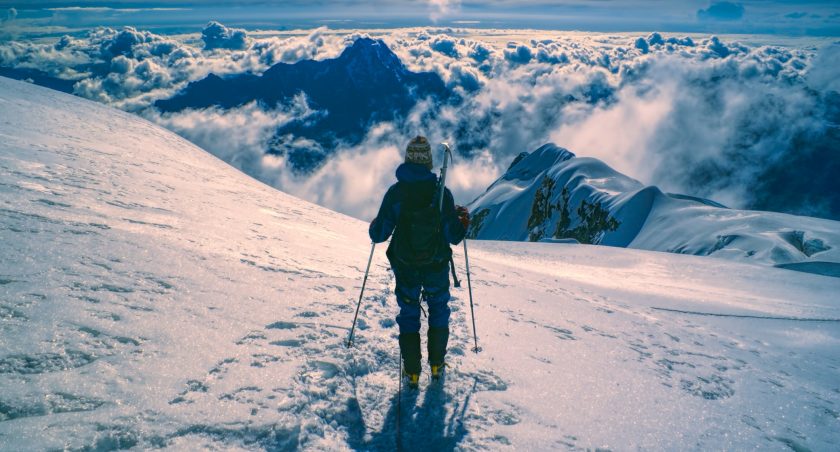
Huayna Potosí stands at 19,975 feet in elevation and is roughly 15 miles north of La Paz, Bolivia. Its close proximity to the city and non-technical characteristics make it a popular climb for travelers. However, you do need to be acclimatized before you go on this trip, as the first night is spent at 15,419 ft. The summit of Huayna Potosí offers magnificent views of surrounding mountains and Lake Titicaca.
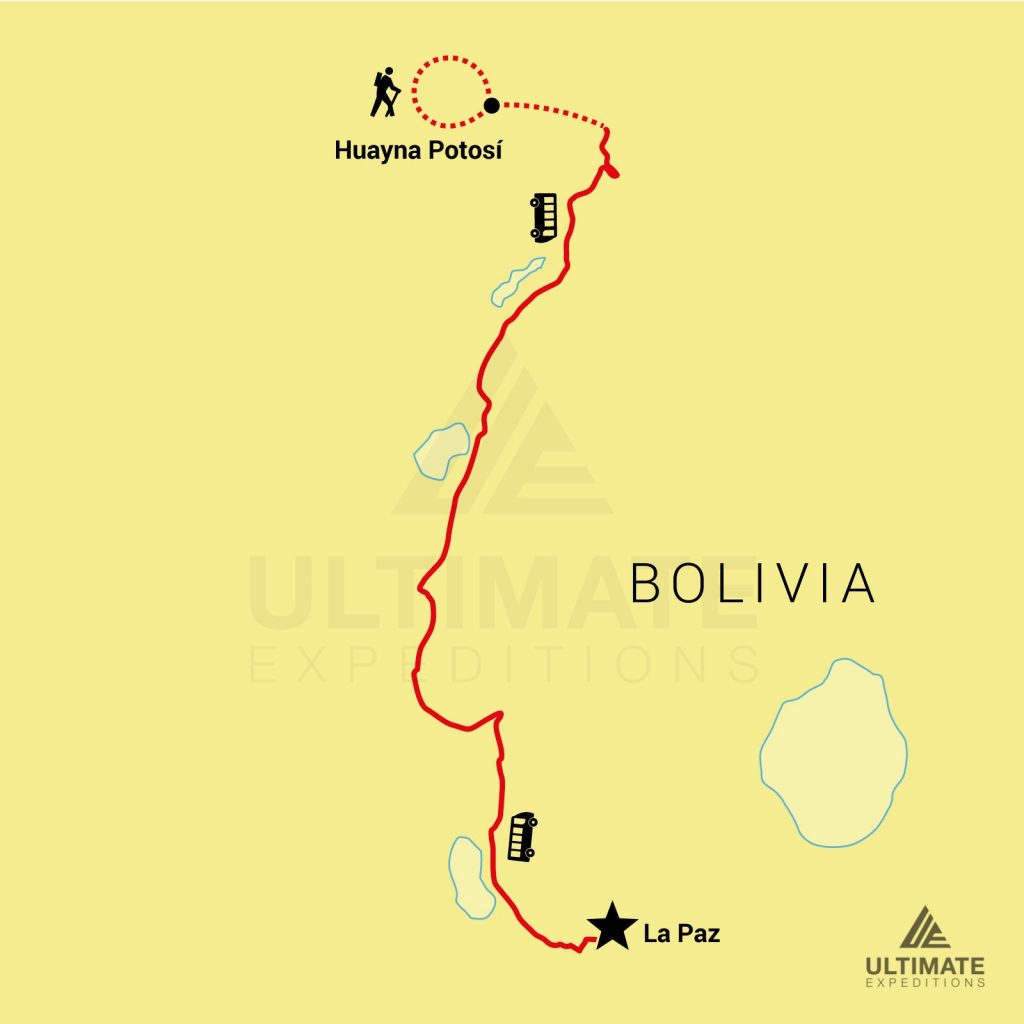
DAY 1 La Paz to Base Camp Elevation (ft): 11,913 ft to 15,419 ft Hiking Time: 3 hours
At 9 am we will pick you up from your hotel in La Paz and drive approximately 2 hours to the platform of Zongo. In the afternoon we will walk to the old glacier at 15,748 feet where our climbing guild will go over the mountaineering equipment and then practice techniques. After the practice, we head back to base camp where stay at a Refugio for the night.
DAY 2 Base Camp to High camp Elevation (ft): 15,419 ft to 16,896 ft. Hiking Time: 3-4 hours
The trail is a well-marked rock path that is a relatively easy hike. High Camp is located on a rock buttress at the base of the glacier and once at camp we will eat, rest and prepare for the summit. Overnight at a Refugio.
DAY 3 High Camp to Summit to La Paz Elevation (ft): 16,896 ft. to 19,947 ft. Hiking Time: 9-13 hours
We have an early morning start around midnight as we head up the glacier. It will be cold and dark, and the ascent will take approximately 6 hours. The climb mostly follows a trail on the glacier with two steep sections; the first is called Pala Chica. The trail continues through a snow and ice wall until the summit is above us, with the last section of the climb on an exposed ridge. Once at the top we’ll enjoy panoramic views of the Andes that include Illimani and Illampu. After photos, we head back to high camp, then onto base camp to meet our transportation that will take us back to La Paz.
END OF SERVICES

- Ground transportation
- Accommodations
- All meals during expedition
- Expert guides and porters
- Bottled oxygen, for emergency rescue only
- Crampons, gaiters, harness, ropes, mountain helmet and ice axe
- Accommodations before and after the expedition
- Sleeping bag (available for rent)
- Plastic boots (available for rent)

- Trip Reports
- Areas & Ranges
- Huts & Campgrounds
- Logistical Centers
- Fact Sheets
- Custom Objects
- Plans & Partners
- Normal Route (Huayna Potosi)

- Additional Parents
- Climber's Log Entries (8)
- Additions & Corrections (4 )
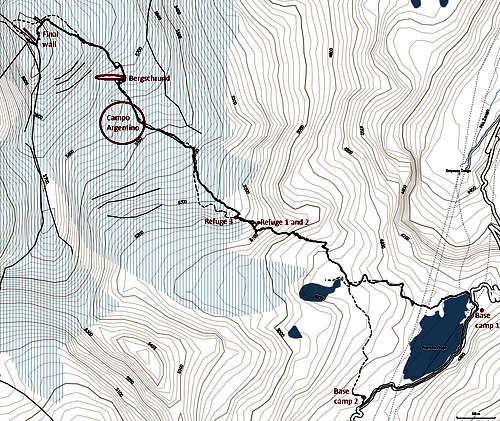
- Getting there

- Route Description
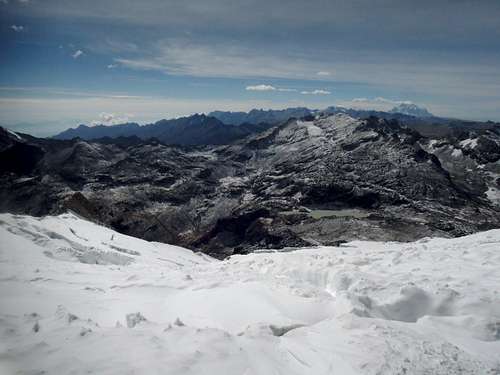
- Essential Gear
- About the guide packages
Additions and Corrections Post an Addition or Correction
Gilles debray - may 29, 2003 8:06 am - hasn't voted.
If youé planning to climb Huayna Potosi you should contact Bolivian Journeys. We did and it is a really good company, their guides are amazing, ask for Eulogio, Vicente or Luis.

Haliku - Apr 8, 2008 9:15 pm - Hasn't voted
Isn't there a second hut now? Updated beta would be great. Cheers!

lenazavaroni - May 24, 2022 2:23 pm - Hasn't voted
I've just completed the two-day climb up Huayana Potosi. It went much as has been described on this site, although I was a bit out of shape and running on empty most of the time! This made my time 8hrs 20 mins, getting to 'la cumbre' at 9:20am. The other two in the group made it by 6am. The weather was optimal (May), meaning crisp, crunchy snow and great visibility. The views from the top in the brilliant sunshine were obviously spectacular, and one could see Lake Titicaca in the distance. I went with Jiwaki, whom I can't praise enough for their professionalism and, in my case, patience!
benbrough1 - Oct 1, 2022 7:24 am - Hasn't voted
We just climbed Huayna Potosi in 2 days (we cycled to the base camp from Condoriri so we were relatively confident of acclimatisation). We booked through Jiwaki tour agency who were incredibly helpful in organising rental equipment and water to be brought to base camp for us. Equipment was generally pretty good; ice axes weren't sized but were adequately sharp and not rusty, crampons were pre-set for our boots, helmets and harnesses we're both Petzl and in good condition, additional clothing was offered (we didn't need it) and was basic but very warm looking! We booked a private guide ~1300BOB but for logistics and convenience they ran the first part of the ascent to the high camp as a group, before we made the final ascent with our guide. The first part of the climb was extremely well run; great food, motivated and friendly guides and time to chat and meet the other climbers in the very comfortable 'Happy Day' refuge. The ascent to the summit went really well, the weather was excellent and we had amazing conditions most of the way. Our guide was both really competent and great to chat to on the way up (William's English was excellent, a real rarity in SA). We summitted around 6:30am, perfect timing for sunrise and were back down to the high camp around 8:30am. All in our experience was incredibly positive; we had considered doing the ascent without a guide (partly due to reports on this site and partly due to experiences in Peru) but in the end we were so so happy we opted for a guided ascent. Unlike our Peruvian guide (who was competent but uncommunicative in Spanish or English), William (and the other Jiwaki guides) really enhanced the experience. We also thought the route finding (around crevasses and across the final glacier approach) was more complex than indicated in other people's reports (although this was likely due to the lateness of the season and the general state of the glacier, I guess conditions and difficulty vary greatly). We didn't find the ascent to be technically difficult, our guide set up an abseil for the short section on to the ridge but down climbing would have been fine for a semi confident climber. Despite reports of 50% successful summit rate, all of the Jiwaki clients made it to the summit that day (there was a huge variety of experience and acclimatization levels) and I think a lot of that can be accredited to the guides. I wouldn't hesitate to recommend Jiwaki to anyone considering climbing Huayna Potosi. Our guide William can also be contacted directly on WhatsApp (+591 63194938) for ascents of any of the peaks around La Paz and further afield, again his English was excellent, his mountain competency was extremely high and his enthusiasm was infectious!
View Normal Route (Huayna Potosi) Image Gallery - 9 Images
- Additions & Corrections
- View Route on Map
- Nearby Routes
- Interactive Map
- Routes in Bolivia
Children refers to the set of objects that logically fall under a given object. For example, the Aconcagua mountain page is a child of the 'Aconcagua Group' and the 'Seven Summits.' The Aconcagua mountain itself has many routes, photos, and trip reports as children.
- Oh my guides! Huayna Potosi by the normal route
Parents refers to a larger category under which an object falls. For example, theAconcagua mountain page has the 'Aconcagua Group' and the 'Seven Summits' asparents and is a parent itself to many routes, photos, and Trip Reports.
- La Via de los Franceses
- American Route/Vía de Lyon
You need to login in order to vote!
Don't have an account.
- Rating available
- Suggested routes for you
- People who climb the same things as you
- Comments Available
- Create Albums

Explore the world with tourHQ
- Destinations
- I am a Guide
- I am a Traveller
- Online Experiences
- Currency (USD)
3-Day Huayana Potosi trek
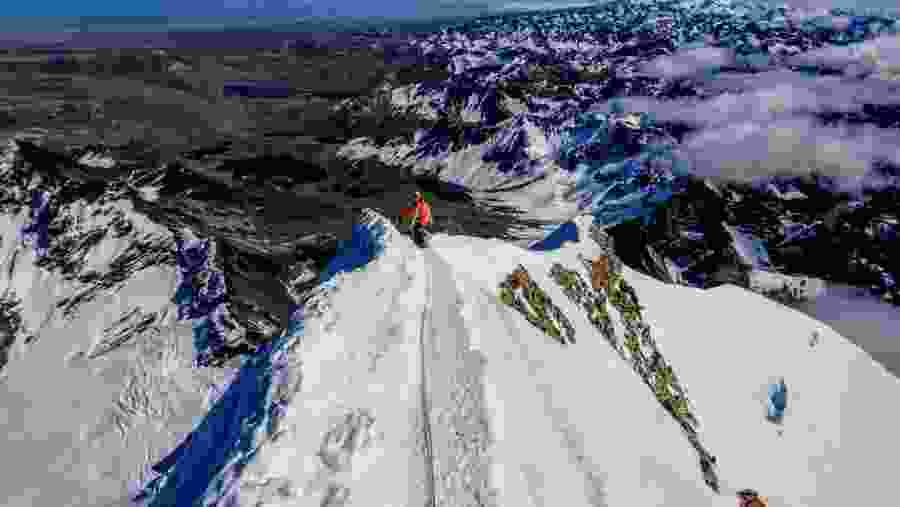
mountaineering, climbing, walking
Dutch, English, Spanish
Description
Summit the Huayna Potosi in the northeast of La Paz, one of the easiest 6000m mountains to climb in the world and deservedly one of Bolivia’s most popular climbs. A complete beginners trek with amazing, magnificent views of the Cordillera Real, Lake Titikaka, and the Altiplano, this is a trek to not miss!
Day 1: La Paz to Pasa Zongo
- Drive from La Paz to Paso Zongo.
- Once at Paso Zongo, have some lunch.
- Walk to the lower glacier after lunch.
- Learn some basic ice climbing and mountaineering techniques at the lower glacier.
- Practice these techniques with the guides and our climbing equipment.
- Revise ice climbing techniques on small ice walls with safety ropes in place.
Overnight stay.
Day 2: High Camp trek
Climb up to high camp. High camp is on a rock buttress at an altitude of 5200m, at the base of the glacier. The walk is on a well-used rock path.
Get your gear ready for the next day.
Rest and rehydrate for the rest of the day.
Day 3: High Camp Summit
- Start climbing with your crampons on and the rest of your climbing gear.
- Follows a trail on the glacier as you climb. There are 2 steep sections you will come across, one at around 5600m, called the Pala Chica. Here the trail goes through a small ice and snow wall.
- Continue the trail on the glacier up to 6000m.
- View the summit from here. The last section of the summit offers great climbing.
- Have a short rest and then pack our gear to head back down to base camp.
- Transport back to La Paz.
What's Included
What's excluded, know before you go, meeting point, cancellation policy.
For cancellations upto 2 days before the tour -
Check Availability Hide
Starting from, can't find the perfect tour tailor your dream trip, create your own adventure, choose currency close modal.
- USD US, dollar
- GBP British Pounds
Cookie icon We use cookies!
We, and third parties, use cookies for technical and analytical purposes, for marketing purposes and for integration with social media. For more information, refer to our Privacy Policy and Terms of Consent.
By clicking on 'I agree', you consent to the use of these cookies.

Huayna Potosi
The 6k most accessible mountain.
Welcome to one of the most popular mountains in Bolivia, this mountain has two main routes, the normal route which is easy for the majority and the French route which is for people who already have mountain experience and want a greater challenge, it is coveted for being one of the most accessible 6000 mountains and emblem of the city of El Alto.
Cordillera Real
6,088m. / 19,973ft
3 Days / 2 Nights
Day 1. La Paz – Base Camp Huayna Potosi – Old Glacier Pick up from hotel in the city of La Paz and transfer to Huayna Potosi base camp (4,750m). and practice on its old glacier.
Day 2. Base Camp – High Camp Huayna Potosi Short trek from Base Camp to High Camp (5,150), approximately 2-3 hours.
Day 3. High Camp – Summit Huayna Potosi – La Paz Early departure from the high camp to the summit (6,088m) and return to your hotel in the city of La Paz.
- Private transportation.
- Mounatain Guide.
- Technical gear (boots, crampons, gaiters, harness, ice axes and helmet).
- Sunglasses.
- Sleeping bag.
- Other material for personal use.
Huayna Potosi Gallery

SALE ENDS SOON!
DISCOUNT ON ALL PRO+ FEATURES

Huayna Potosí Trek
Pedro Domingo Murillo, Bolivia
"An epic challenge to remember from the heart of Pedro Domingo Murillo"
The Huayna Potosí Trek is a 5.4 km trail that starts in La Paz, Pedro Domingo Murillo, Bolivia. Based on our data, the trail is graded as Extra Difficult. For information on how we grade trails, please read measuring the difficulty of a hiking trail on hiiker . Also, check our latest community posts for trail updates. This trail can be completed in approx 2 days. Caution is advised on trail times as this depends on multiple variables. For more info read about how we calculate hike time .
WHAT TO SEE
Refugio nuevo Llaulini
WHERE TO STAY
User comments, reviews and discussions about the Huayna Potosí Trek, Bolivia.
average rating out of 5
1 rating(s)
Nearby Trails

Cordillera Real Traverse
Provincia Omasuyos, Bolivia
216.2 km · 6166 m

El Choro Trek
49.1 km · 1136 m
- +591 - 2301375
Kothia – Huayna Potosi
5 days of hiking through the cordillera real., view our image gallery.

Tour Summary
This trek is a great way to get close to the beauty of the Cordillera Real without needing to do any technical climbing.
DID YOU KNOW?
This is our most popular trek since it can be easily customised to our client’s desires. We can add mountaineering summits onto the itinerary: see the Expeditions section for more information.
We leave La Paz and drive to Laguna Kothia (4570m) where we pack our luggage onto the donkeys that will accompany us on our trek. We then progressively gain altitude until we reach our first pass (4820m), from where we can see Lake Titicaca and the altiplano. We start descending towards Ajuani (4580m) which serves as our first camp.
After a good breakfast we climb to a pass where we get our first look at the imposing Huayna Potosi (6088m) and the Condoriri Massif. We then descend down a moraine to Laguna Sistaña (4500m), before climbing to our second pass of the day. Finally, we descend to Laguna Jurikhota (4600m) to set up camp and have a well-deserved dinner.
We start today by making our way to Laguna Glacial (4900m) at the foot of the Condoriri massif. After a short break we continue to Austria Pass (5150m) and either climb to Pico Austria (5300m) or descend to our campsite at Laguna Chiar Khota (4600m).
Today we will only cross one pass, Jistaña (4900m) after which we descend to the Racacha valley, passing through old mining centres. We finish the day at the base of the Western face of Huayna Potosi (6088m) and Maria Lloko (4450m).
Today is a short hike of only 3 hours. We climb to Huallatani (4850m), the last pass of our trek, and then descend to Huayna Potosi’s base camp (4700m) where we will have our last lunch in the mountains before driving back to La Paz.
Private transport.
Bilingual tour guide (Spanish- English)
Food during the expedition.
Logistics transport equipment (donkeys / mules)
Camping tent (NORTH FACE OR SIMILAR)
Cooking utensils
THERMAREST PLUS ROLL MAT
Dinning tent at base camp
National park tickets
Please take with you:
Rucksack (35Lts)
Big Rucksack or Duffel bag (To be carried by porters or mules)
All seasons sleeping bag
Trekking boots
Winter underwear
Waterproof jacket
Sunglasses with UV filter
Bottle of water (NALGENE)
Tour details:
Altittude: Min. 4600m.(15.000 fts.)Max 5350m.(17.550 fts)
Days: 5 days, 4 nights
Season: May to September
Activities: Trekking
Difficulty: MOUNTAIN HIKE
Location: Cordillera Real
Guide: English /Speaking
Experience: Basic/Medium
Cost: From $ 700
Who?: 100% Guarantee
Illimani Climb 1 Day Tour Book Now
Book Now Trip


Destinations
Trekking type.
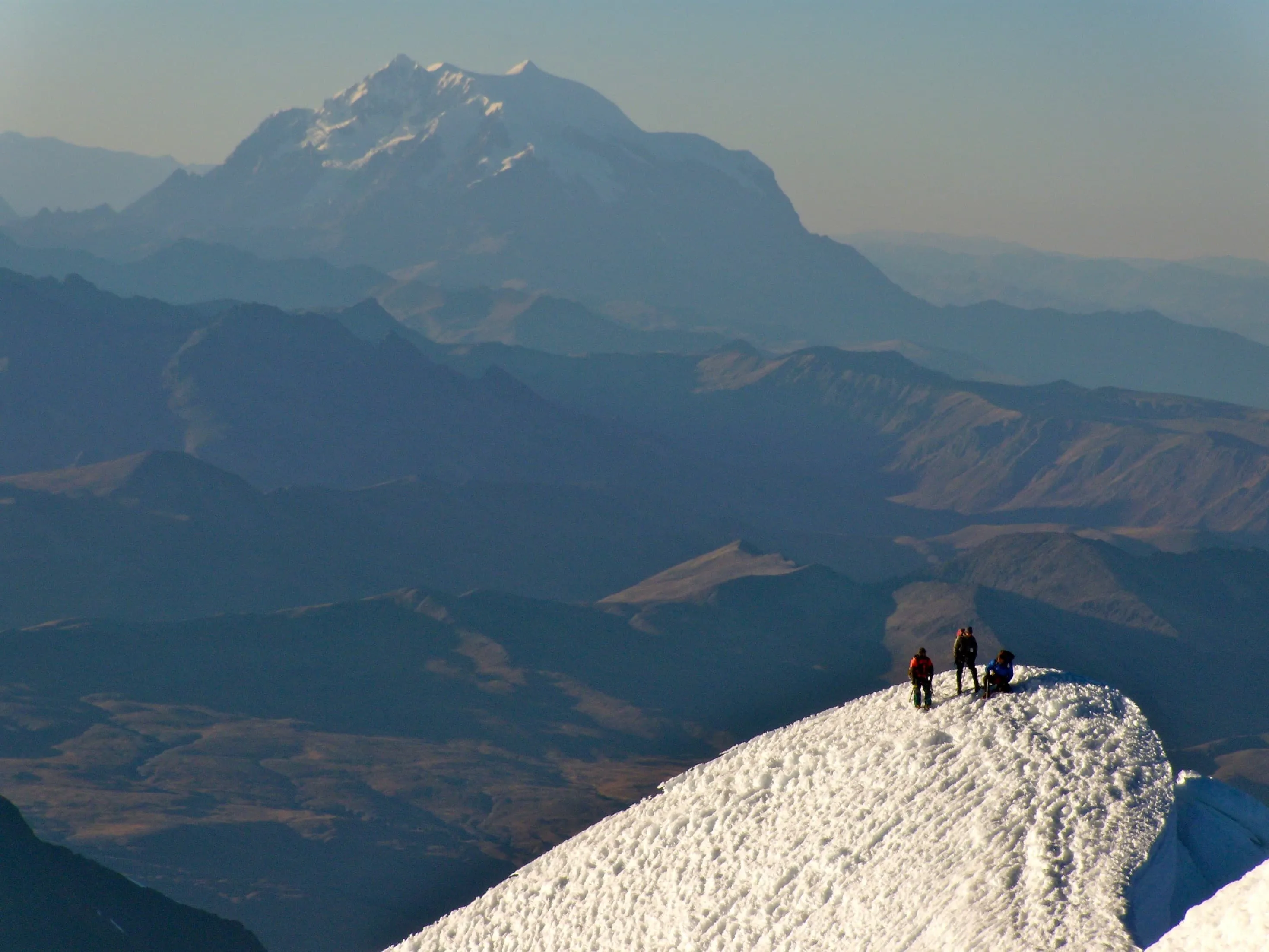
Huayna Potosi Trek
- What's Included
> Enjoy spectacular views at sunrise on your way to the top > Trek over a glacier > Spend your night in the Refugio at High Camp
Bolivia´s Most Popular climb Huayna Potosi (6088m) is northeast of La Paz in the Cordillera Real and is known as one of the easiest 6000m plus mountains to climb in the world. Deservedly one of Bolivia’s most popular climbs and after just one hour of driving and 3 hours of walking you will be at the high camp. Huayna Potosi can be climbed by complete beginners and provides amazing views of the Cordillera Real, Lake Titicaca (3810m) and the Altiplano (4000m). If hoping to climb higher mountains in the area, Huayna Potosi is a good starter! The two-day climb is better for people with some experience and are well acclimatized.
Important: You must go to the local agency office 1 or 2 days before your adventure to try on your climbing equipment.
La Paz - Paso Zongo - High camp
We drive from La Paz to Paso Zongo (4700m). From Paso Zongo, we start to trek up to high camp. High camp is on a rock buttress at an altitude of 5200m and at the base of the glacier. The walk up in on a well-used path on rock. Once at high camp, we need to get our gear ready for the next day, as we have an early start in the morning. We also have time to rest and rehydrate. It’s an early night tonight where we sleep in the Refugio.
Drive: 1 ½ hour drive
Walking time: 2 - 3 hours
Accommodation: Refugio

High camp – Summit (6088m) – High camp - La Paz (3600m)
We have an early start in the morning. We will leave around 1 am in the morning. It will be cold so we want to dress well. The climb starts on the glacier, so will start with our crampons on, and the rest of our climbing gear. The climb mostly follows a trail on the glacier. We have 2 steep sections, one at around 5600m, called the Pala Chica. The trail goes through a snow and ice wall. Once through this part, we keep following the trail on the glacier up to 6000m. From this point, we can see the summit above as. The last section to the summit is great climbing on an exposed ridge. From the summit, we can see from Illimani (6439m) to Illampu (6368m). After we take our photo shot on top, we head back down the same way to high camp. Once back at high camp we have a short rest and pack our gear. We then head back down to base camp to meet our transport back to La Paz.
Walking time: 9 - 13 hours climbing
Drive: 1-hour drive
All necessary transfers (bus, taxi, private transport, etc.) as described in the itinerary are included.
Accommodation in refuges
During your trek, you stay in refuges. These are simple in nature but fully equipped. Do not expect too much luxury.
This trek includes breakfast, lunch, and dinner.
Professional guide
During your trek, you will at all times be accompanied by an English speaking guide.
Mountain and climbing equipment
All mountain equipment necessary such as crampons, harness, plastic boots, windproof pants and jacket, ice axe, gloves, gaiters, helmet, and balaclava are included in the price of the trek.
Traveling to and from
This trip does not include costs for transportation (flights, bus travel, etc.) to your destination.
Sleeping bag
You must bring your own sleeping bag with you. You can rent a sleeping bag from your trekking company.
Gratuities for the guide are not covered by the trek's price. The amount to tip is at your discretion, yet if you've received excellent service from your guide, considering a generous tip is appreciated.
Travel Insurance
Your international travel insurance is your own responsibility. It is important that your travel insurance also covers adventures at a high altitude. Discuss your itinerary with the insurance company before your trek.
Accommodation before and after the trek
Before and after the trek you have to take care of your own accommodation.
Personal expenses
Personal expenses such as souvenirs, drinks at the bar and other similar expenses are your own responsibility.
Where is Huayna Potosí?
Huayna potosí - difficulty, how to book, availability, cancellation policy.
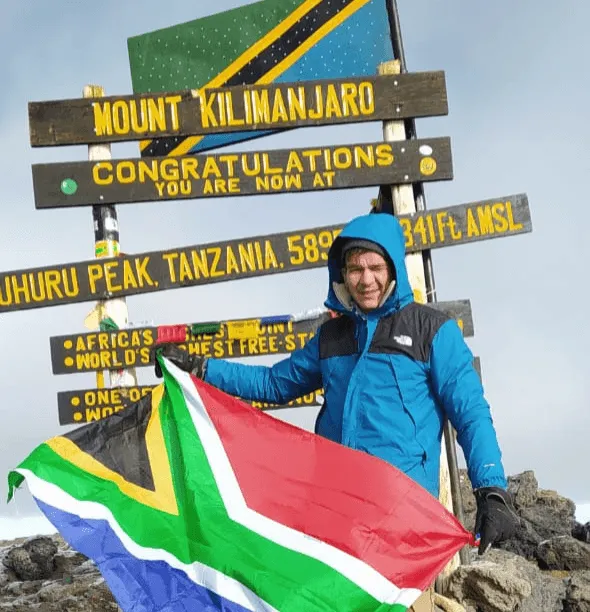

Just for You

Huayna Potosi Climb

Huayna Potosi, climb to the summit

Summit climb Huayna Potosi
Get weekly inspiration with the best treks.

You are using an outdated browser. Please upgrade your browser or activate Google Chrome Frame to improve your experience.

- Select Language English French
- Destinations
- South America Tours Calendar
- South America Tour Finder
- Late Availability
- Inspirational Journeys
- Argentina Travel Highlights
- Bolivia Travel Highlights
- Chile Travel Highlights
- Colombia Travel Highlights
- Ecuador Travel Highlights
- Galapagos Islands Guide
- Patagonia Travel Highlights
- Peru Travel Highlights
- Peru Trekking Highlights
- Peru Amazon Rainforest
- Useful Links & Resources
- Books & Guides
- Health & Safety Travel Advice
- Meet the Team
- Our Partners in South America
- Andean Trails Background
- Responsible Travel – Our Ethos
- Community Projects
- Paramo Clothing Discount
- Testimonials and Reviews
- South America Flight Advice
- Make a Payment
- Booking Conditions
- How to Book with Us
- Travel Insurance
- Why Book with Us?
Condoriri Trek & Huayna Potosi Climb
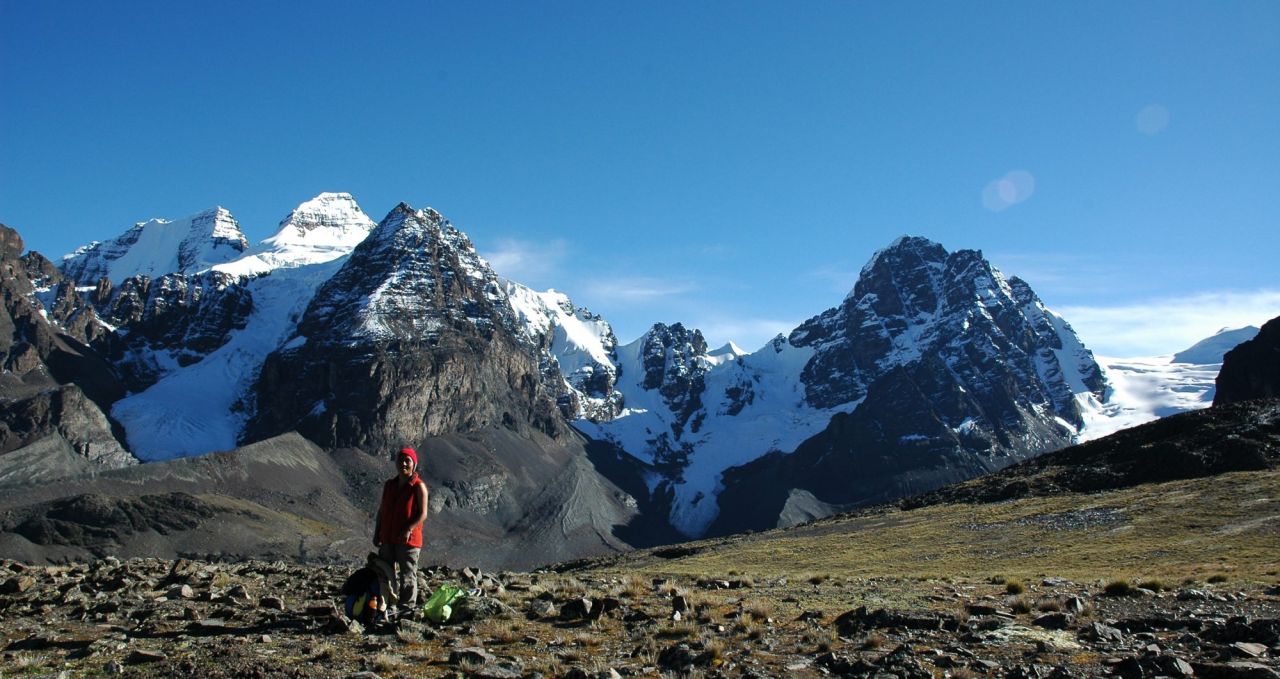
Combine the Condoriri trek with a climb of the spectacular Huayna Potosi peak.
Join us for some superb high altitude hiking and mountaineering in Bolivia.
Hikers love walking and hiking in the majestic Cordillera Real mountain range. This area is great for spotting condors and Real’s outline resembles this iconic Andean bird taking off.
We walk up close to beautiful glaciers, lakes and are always accompanied by mountain views on the trails.
This fully-supported hike runs smoothly thanks to our professional guides, a cook, pack animals and full support staff team.
More on Condoriri trek and Huayna Potosi
Having spent most of the trek above 4,500m/14,764ft, you will be well acclimatised for our next goal.
Huayna Potosi (6,088m/19,974ft) itself is a relatively easy ascent for such a high peak. It is the perfect Andean mountain for novice or experienced mountaineers.
The summit provides amazing views of La Paz, El Alto, Illimani, Mururata, the Amazon Basin, Condoriri, the Cordillera Real, Altiplano and even Lake Titicaca.
Read our blog with tips and advice on how to make it to the summit.
Trip Highlights
Stunning mountain views of the Cordillera Real.
Remote Andean valleys.
Ascent of 6,088m Huayna Potosi.
Get up close to the Condoriri mountains, glaciers and lakes.
The descent was also magical, seeing the terrain we'd hiked in the dark in all is spectacular icy glory.
T. Foster, Huayna Potosi climb
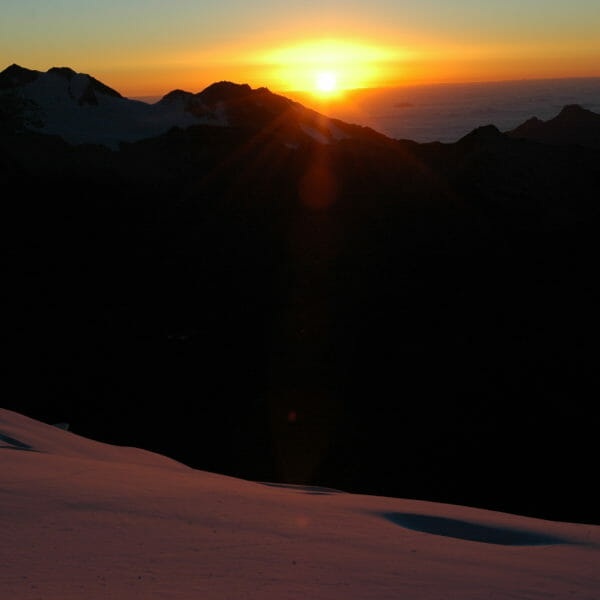
Full Itinerary
Day 1: drive la paz to rinconada, trek to laguna jurikhota (4,700m), camp (l,d).
Transfer from La Paz to Palcoco (2 hours), an agricultural farming community.
From here we head off to Palcoco valley, and travel through here for 40 minutes to arrive at Rinconada (4,400m/14,436ft). We have lunch here and then set off hiking.
It’s three hours trek from here to our destination, Laguna Jurikhota (4,700m/15,420ft).
Here we camp, at the base of the glaciers of Ala Oeste.
Day 2: Condoriri glacier, Austria pass (5,150m) to Laguna Chiarkhota, camp (B,L,D)
Today we’ll be up well over 5,000m/16,404ft as we hike over a pass to Laguna Chiarkhota (4,650m/15,256ft).
After breakfast we head up to 4,900m/16,076ft to take a close-up look at the Condoriri glacier. We get a good look at frozen lakes and the seracs here. Seracs are blocks or columns of ice formed by intersecting crevasses on a glacier.
From here we push up and over the Austria pass (5,150m/16,896ft) and enjoy its views, before descending to Laguna Chiarkhota (4,650m/15,256ft) where we set up camp following today’s 6-hour trek.
Day 3: Hike to Maria Lloco, camp (B,L,D)
A similar length of trek today (6 hours), we start out after a lovely breakfast along a path that traverses lakes and abandoned mines.
These lovely distractions help pass the time until we arrive at Maria Lloco, a campsite with incredible views.
Our base will be facing the spectacular east face of our goal, Huayna Potosi.
Day 4: Short trek to Huayna Potosi base camp (B,L,D)
A four-hour uphill trek to start the day to reach a high pass of 5,050m/16,568ft, Paso Milluni.
From here we can see the snows that surrounds the glaciated peak of Huayna Potosi (6,088m/19,974ft).
We descend rapidly on the other side of the pass for about 90 minutes to get to the basic mountain refuge at the foot of Huayna Potosi (4,760m/15,627ft), for a warming cup of tea and a chance to relax.
Day 5: Trek from base camp to mountain refuge (5,130m) (B,L,D)
After breakfast, we start trekking up a rocky track through the morraines of Huayna Potosi. This is typical of walks in to the base of glaciers in a high mountain environment and does not require the use of any climbing equipment.
After two to three hours we arrive at Refugio Rocas (5,200m/17,060ft), located right near the glacier base, where we will cook up some supper and spend a short night.
This is an extremely basic mountain refuge.
Day 6: Trek from refuge to summit (6,088m), return to La Paz (B,L)
After breakfast at 1am, we will prepare our mountain gear to start our summit climb at 02.00.
The normal route is not particularly technical though it does help if you have previous high mountain experience and experience of use of an ice-axe and crampons.
The ascent presents two steep sections, the first at 5,700m/18,700ft, and the second at 5,900m/19,357ft.
We will be roped up at all times and the guides will be instructing in how best to move all the way up.
After 5-6 hours we will reach the summit (6,088m/19,974ft) and enjoy an incredible 360º view.
Returning to high camp (3 hours), we have a quick lunch and return to base camp (1 hour) from where we return by vehicle to La Paz, arriving there late afternoon.
Prices From $1,981 / £1,611 per person
Enquire about booking
What's Included?
English speaking trek guide, cook, mules or llamas for kit transport, cook and dining tent, all group camping equipment, private transport to and from the trek, meals and water, Condoriri entrance fees, refugio fees, mountain guide.
What's Not Included?
International flights (we can look for these for you), travel insurance, sleeping bag, mountain clothes, items of a personal nature and tips, La Paz hotels
Accommodation
On the trek, we use two-man, high mountain tents. There is a dining tent and toilets are a mix of toilet tent and latrines.
On the climb we use two local mountain refuges on this route – both are basic.
All guides are certified, bilingual, English-speaking guides who have worked with us for many years.
Cooks, mule drivers and additional staff are all from the local communities and we have worked with them for a long time.
Vegetarians and many other dietary requirements are catered for without problems. Please let us know in advance of any requirements you have.
You wake early, usually around 07.00. Breakfast is served in a dining tent, and consists of hot drinks, porridge, toast, jams and bread, and your guide will explain the day’s plans.
Lunch is usually around 13.00 and can feature soups, meats, salads and fish, with vegetarian options and hot drinks too.
The campsites are comfortable and around 17.00 hot drinks, popcorn and other snacks are served to help you recover energy.
Dinner is served around 19.30, and will feature pasta, quinoa, mashed potatoes, meat, fish or vegetarian options, followed by hot drinks and a pudding.
Activity Level
The trip is open to anyone with a positive attitude, but the fitter you are, the more you will enjoy it as climbing at high altitude is always a breath-taker.
We spend several days walking at high altitude, going over high passes, and spend a large amount of time above 4,500m/14,764ft.
You need to have a very good level of fitness for this trip, as summiting a peak higher than 6,000m/19,685ft requires fitness and determination.
You will need to have spent a good few days acclimatising in La Paz (3,655m/11,911ft) or higher, as well as doing some acclimatisation walks to higher altitudes – please ask.
Practical Information
An introduction to bolivia.
Land-locked Bolivia is a country of dramatic landscapes and fascinating native cultures and traditions.
The Altiplano or “High Plain”, averaging 3,800m, is its most populous region. The vast, luminous plateau is flanked to east and west by parallel Andean ranges.
La Paz, the world’s highest capital, lies in a deep canyon at the edge of the Altiplano, and at the foot of Illimani (6,400m). It is a striking city for its dramatic setting and its strong Indian character.
Lake Titicaca is the world’s highest navigable lake. It was sacred to the Incas; according to legend, their founding emperor-gods rose from these waters to give birth to their empire. Just south of the lake stands the sacred pre-Inca site of Tiahuanaco.
Geography of Bolivia
On the south-western Altiplano are the Uyuni Salt Flats, the largest in the world. Here, the shimmering white salt pan and deep blue sky combine to create a truly magical spectacle.
The stunning Cordillera Real is a mountain range dominated by huge snow peaks, including Illimani and Illampu (6,380m). The Real divides the northern Altiplano from the tropical forests to the east. The Cordillera Real’s eastern slopes are characterized by the deep, sub-tropical Yungas gorges.
Further south, the tropical Chapare is the agricultural heart of Bolivia. East of this band of high forests and plantations lies Bolivia’s Oriente, a vast swathe of Amazonian jungle and savanna accounting for 2/3 of the country and featuring some of the last untouched wilderness on earth.
In the north-eastern Department of Beni, some 50% of the country’s mammals and birds reside. Below, and in no special order, we outline some of the top places to go and things to do.
Weather in Bolivia
Bolivia lies within the tropics, between latitudes 10º and 22º south. The climate, as varied as its geography, is affected by latitude and, especially, by altitude.
The best time to travel is the winter (dry season) between May and Oct when, typically, weather systems over the Andes are stable, and overall you can expect bright sunny days and cold clear nights. Most of the rain falls from Dec to March. Climate can be divided into these distinct zones:
The Andes and the Altiplano
There is relatively little precipitation on the Altiplano, especially in the dry season – most rainfall is from Dec to March. However, there is periodical, localised rain on high peaks and valleys all year round.
The further south and west you go on the Altiplano, the drier are the conditions; around Uyuni, semi-arid conditions prevail. The Andean sun’s rays are very strong.
Temperature-wise, the Andes and Altiplano experience significant fluctuations over a single day. At 4,000m, the pre-dawn temperature can drop to -15ºC, while noon temperatures at the same location can reach 20ºC.
Southerly cold winds mean the southern Altiplano is not only drier, but also noticeably colder and windier than the north (pre-dawn temperatures at Uyuni in July regularly drop to -20ºC).
On treks in the Cordillera Real in the dry season, expect a range of conditions within a single day: cold/freezing nights at camps above 4,000m (where pre-dawn temperatures sometimes reach -15ºC); warm, spring-like mornings and afternoons; and cold evenings. Conditions are generally dry, but note that mountain weather is fickle and localised, and precipitation is not unusual in the dry season.
Expect temperatures to swing between sun and shade, sheltered and exposed ground and with altitude gain and loss. A quick-setting sun means temperatures drop fast.
The city of La Paz (3,630m) is relatively sheltered. Average high/low temperatures range from 1-17ºC in June and July (coldest months) to 6-19ºC in Nov and Dec (warmest months). In June and July, it rarely rains more than 1 or 2 days per month, while in January there are on average 15 wet days.
The tropical lowlands & yunga (Amazon)
Year-round, weather conditions in the Amazon basin are hot and humid and always with the chance of rain.
There is a ‘cooler’, drier winter season between May and October. During this ‘dry season’, the average daytime high temperature is between 25-31°C and the average nighttime low is between 16-22°C.
In the dry season, heavy downpours typically occur every few days.
Note that around 80% of annual average rainfall – approx 2,000 mm in Bolivia’s northern lowlands – occurs in the wet season, Nov-April.
On rare occasions, between May and September, cold fronts from Argentina – surazos – can sweep into southwest Amazonia and push temperatures down to 9°C. (Surazos usually last between 1 and 3 days).
The Yungas shares the same dry/wet months but varies from quite wet to very wet depending on whether it is the ‘dry’ or rainy season. Average temperature is 24°C.
Good kit is vital for every trip.
Book with Andean Trails and get 15% off Páramo’s fantastic ethical and high performance outdoor gear.
When planning for the extreme climatic conditions encountered on high peaks in the Andes, layering is the most practical and versatile clothing system. It’s worth remembering that our clothing keeps us warm by retaining and isolating the heat we ourselves create.
To best maintain body heat, several layers of lightweight, warm and quick-drying clothing are far more efficient than one or two thick layers.
Layers should have the following qualities:
- Breathability (able to wick away the humidity produced by sweat);
- Isolation (able to keep in the warm air our body produces); and
- Impermeability (able to impede the passing of wind and water).
First (base) layer: This layer wicks the sweat away from our skin, thus helping keep the body dry and warm. To this end, synthetic fabrics such as polypropylene should be used.
Mid layers: These isolating layers should also be synthetic (e.g. the known polar linings such as polartec or windblock, which are light and insulate twice as well as wool). Very important layers for retaining body heat.
Outer layer / shell: Finally, the vital layer which protects us from climatic adversities. A breathable, wind-proof and waterproof anorak, such as Goretex.
Note that it’s our extremities that stand to suffer the most, and on high Andean peaks the poorly-equipped mountaineer is at risk of becoming frostbitten. Hence, much thought should be given to deciding how best to protect hands, feet and head.
Give plenty of thought to kit selection, and try to keep weight down.
Below is a more detailed guide.
- 2 pairs synthetic inner socks (e.g. polypropylene, thermastat, coolmax)
- 4 pairs thick loop-stitch/wool socks for cold.
- Trekking boots – should be well broken-in, waterproof and provide good ankle support. Given the extreme cold, plastic mountaineering boots (e.g. Koflach) are also required. These are indispensable. (see ‘TECHNICAL KIT’ below)
- Gaiters (1 pair), heavy and large enough to fit over plastic boots.
- Trainers/sandals, for city-wear, evenings at lower camps & river crossings.
- Base layer leggings (1-2 pair).
- Thick fleece leggings (or salopettes) (1 pair).
- Goretex-type over-trousers (or salopettes) (1 pair).
- Trekking trousers (1 pair).
- Shorts – wear sparingly in early stages at altitude, as sun burns.
- Thermal base layer shirts (2).
- Microfleece mid-layer shirt (1).
- Shirt/T-shirt 1 or 2 for lower altitudes. Long-sleeved, collared shirt protects against sun.
- Fleece jacket or similar (1).
- Warm jacket (down or synthetic) with hood. For camp and upper slopes.
- Waterproof Goretex-type jacket.
- 1-2 sports bras/tanks (for women)
Head and neck
- Broad-brimmed sunhat, essential.
- Warm hat, fleece or wool. (N.B. Up to 30% of body heat can be lost through the head).
- Balaclava/full-face ski mask (1)
- Sunglasses with UV filter and nose and side-pieces.
- 1 pair of glacier compatible sunglasses (full coverage – ask salesperson if you are not sure)
- Scarf for cold.
- Bandanna – to protect neck from strong sun.
- 1 cap with visor
For the extreme cold, we recommend a 3-layer scheme:
- 1 pair of Gore-Tex shell gloves
- 2 pairs of removable fleece glove liners
- Mittens allow you to keep the fingers together, and better conserve heat (though they also make it difficult to perform certain tasks).
Technical kit
- Large backpack (80-90 litres). Comfortable and with waterproof lining or cover.
- You will need another bag to store belongings left at hotel during expedition.
- Daypack (at least 30 litres). Comfortable and with waterproof lining or cover.
- Plastic mountaineering boots (you can rent these)
- Crampons, strap-on or step-in (can be rented)
- Walking ice axe (can be rented)
- Pair of telescopic trekking poles. (can be rented).
Other expedition kit
- Sleeping bag – a good warm bag (‘4-season’, minimum) and liner will be necessary for high-altitude camping.
- Sleeping mat, a foam mat is provided
- 2 x water bottles (2 litres each approx).
- Pee bottle.
- Personal first-aid kit to include: painkillers, plasters (band-aids), moleskin, anti-biotic cream, general antibiotics (ask your GP), after-bite (tiger balm), anti-diarrhoea tablets, throat lozenges, re-hydration salts & personal medication.
- Towel & wash-kit.
- Wet Wipes/antiseptic hand-wash cream.
- Sunscreen (factor 40+) and lip salve.
- Head-lamp (Plus spare bulbs and batteries x 2 at least).
- Thermos flask (1 litre) Stainless steel.
- Alarm clock.
- Plastic bags ‘Zip-loc’ & tough bin liners.
- Camera and film / memory cards (take at least twice the amount you think you will need!).
- Book, e-book, mp3 player/ipod or other for free time.
- Binoculars.
- Spanish/English phrasebook.
- Extra snacks i.e. cereal bars or favourite chocolate bars.
All other non-personal trekking and camping equipment is provided, e.g. tents, cutlery etc.
ATOL holiday protection
Andean Trails has 25 years of experience of putting together the best South America holidays.
We pay a fee to the CAA for every licensable passenger we book since we hold an Air Travel Organiser’s Licence granted by the Civil Aviation Authority. In the unlikely event of our insolvency, the CAA will ensure that you are not stranded abroad and will arrange to refund any money you have paid to us for an advance booking.
We also offer ATOL (Civil Aviation Authority) protected holidays to give our customers peace of mind when booking and travelling.
When you buy an ATOL protected air holiday package from Andean Trails Ltd you will receive a Confirmation Invoice from us confirming your arrangements and your protection under our Air Travel Organiser’s Licence number 6275.
You can read more about ATOL, who is covered and what protections you have if not ATOL-covered, on our ATOL page.
What is ATOL?
The CAA’s ATOL scheme offers protection to your money and your holiday if you book with us. Not everybody is covered (see ‘Who is covered?’ for more), as you must purchase an ‘air package holiday’ with Andean Trails to be protected.
And ‘air package holiday’ is defined as including a flight and some ground services (hotel, transfer, trek etc). This is also known as an ‘ATOL-protected holiday’.
Who is covered?
To be covered by ATOL, you must book a flight and some ground services with us and be from the UK. If you are from the UK and only book ground services and no flights, you are not covered by ATOL (see below for more on how non-ATOL clients are covered).
If you are outside the UK and buy flights with us, you will be ATOL protected IF any of the flights booked with Andean Trails touches/stops in the UK at any point during your holiday package booked with us.
If you buy your flights elsewhere, please check with that agent if you are ATOL protected. Be careful with online flight purchases and make sure you know what protection you have, if any, before paying for flights.
Not all holiday or travel services offered and sold by us will be protected by the ATOL scheme. Please ask us to confirm what protection may apply to your booking.
For land only holidays not involving any air travel, in accordance with “The Package Travel, Package Holidays and Package Tours Regulations 1992”, all UK passengers booking with Andean Trails Ltd. are fully protected for the initial deposit and subsequently the balance of all money paid to us, arising from cancellation or curtailment of travel arrangements due to the insolvency of Andean Trails.
I’m not ATOL covered, what protection do I have?
If you are not ATOL covered, any payments you make to us go to a Trust account.
We can only access this money once your tour has been completed, meaning that if anything happens to Andean Trails Limited while you are on holiday, then your money is secure and you can either complete the trip or be able to make it home.
If you pay for your holiday with a credit card, some offer payment protection – please check with your cardholder.
You also should have cancellation protection written into your insurance (which we recommend you have at the time of booking) in case you need to cancel.
2024 price, per person, shared tent basis Shorter/longer climbs possible Price based on two people 4 people: USD 1,422 per person Season runs May-September
Dates & Prices
Can’t find what you’re looking for? Get in Touch
+44 (0)131 378 5593
+44 (0)131 554 6025
Suggested Trips
Climb huayna potosi in bolivia.

What's a group trip?
Join a small group of like-minded travellers on a guided trip.

What's a tailor made trip?
We put together a bespoke tour to fit your requirements.

What's part of a tailor made trip?
Include this guided group tour within your tailor-made tour.
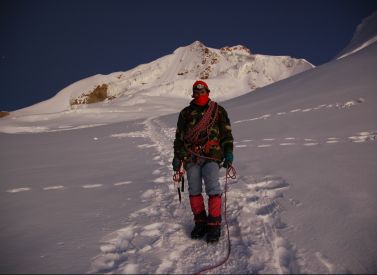
Prices From $926 / £753 per person
Duration: 3
Comfort Level:
Capacity: 16 people
Discover More Enquire about booking
Climb Sajama & Parinacota, Bolivia
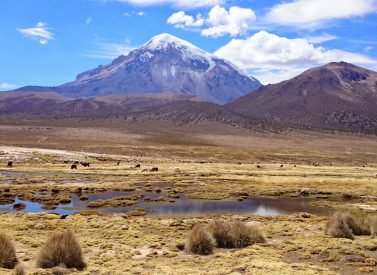
Prices From $4,291 / £3,489 per person
Duration: 17
Condoriri Trek & Hike, Huayna Potosi
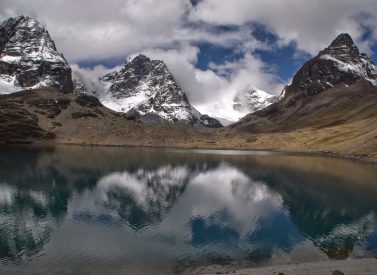
Prices From $1,211 / £985 per person
Duration: 4
Quick Request New
- Latest Twitter Follow Us on Twitter
- Facebook Like Us on Facebook
- Pinterest Follow Us on Pinterest
Chiloé Island Tours and Things To Do

Chiloé Island Tours, Activities and things to Do There is so much to do and see on Chiloé Island that the main issue may be how to fit all those tours and activities into your travel itinerary. The island of Chiloé, in Chile’s Lake District, was once a strategic point of interest for seafarers and pirates alike. Fortunately, for the intrepid traveller, it now seems often overlooked by tourists visiting Chile. Yet it really shouldn’t be, as here you will find a culturally rich land, with landscapes ranging from temperate rainforests to agricultural land of rolling hills to pristine sand …
Read More
- Comments This field is for validation purposes and should be left unchanged.
Sign up here to receive the latest news and info from Andean Trails

Condoriri Trek & Huayna Potosí Climb -5DAYS
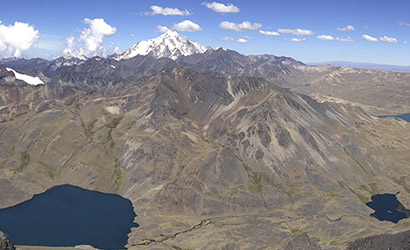
Condoriri trek & Huayna Potosi Climb
This program combines 2 ½ days of trekking through the Cordillera Real, an afternoon of basic mountaineering instruction and practice, and a 2 day climbing of Huayna Potosi (6088 meters) at La Paz – Bolivia.
Our trek begins in the scenic Condoriri region of lakes and glaciated peaks and includes the opportunity to summit Pico Austria.
We then continue through the Andean highlands along the spine of the Cordillera Real and camp at the base of the imposing west face of Huayna Potosi.
We make the transition to the Huayna Potosi base camp.
and spend an afternoon practicing techniques on the glacier on the lower slopes of the mountain. We then spend our final two days in the summit attempt of the Mountain.
Condoriri trek & Huayna Potosi Climb This tour is for all the people who would like to climb over 6000 meter without high knowledge mountaineering techniques. and also who would like to acclimatize with 2 ½ days of trekking before ascend the Mountain.
2 ½ days of trekking will increase your chance of summit success, because on the trek highest point got is (5350 meters) pico autria summit.
that´s why we suggest this tour if your acclimatization is not good enought.
If your acclimatization is good enought and physucally you are good. you can take 3 day climb of huayna potosi or 2 day climb huayna potosi straight from la Paz City .
- Transportation Private transport for the group
- Summit altitude 6088 meters
- Best season April to October
Packing List
Cancellation policy.
7:30am meeting point at our office.
we will drive for around 3 hours out of the city and through the Andean highlands until we reach Rinconada (4500 meters) from where we start the trek.
After an hour of gentle uphill trekking past several small lakes, we arrive at the larger lake of Chiar Khota (4700 meters). From there we begin the steeper ascent of Pico Austria (5350 meters) for around an additional 3 hours until we reach the summit.
From the top of Pico Austria, we have a spectacular view of Mt. Condoriri, with its shape of a Condor with its wings spread wide, Lake Titicaca, the west face of Huayna Potosi, and numerous other peaks of the Cordillera Real. Our descent to Chiar Khota will take around 1 hour.
We will spend the night at Chiar Khota.
This day hiking time will be 5 – 6 hours (8,7 km.)
On this day from Chiar Khota Lagoon 4700 m. / 15419ft. . After the breakfast we go direction to Maria Lloco Camp (4700 m. / 15419ft. )
During our trek, we will cross over two passes, the first with an elevation of (5000 m. / 16404 ft) and the second with an elevation of 4900 m. / 16076ft Along the way we will observe the typical fauna and vegetation of the high altiplano.
After around 8 – 9 hours of trekking, we will arrive at our second camp, Maria Llocko (4700 m. / 15419ft. ). Maria Llocko is a scenic spot at the base of the mighty west face of Huayna Potosi and is where we will make our camp .
This day hiking time will be 8 – 9 hours (12 km.)
Today our 3 hours trek will take us from the west side of Huayna Potosi and over a pass of (5100 m. / 16732ft ) After crossing over into the next valley we end the trekking at 10:30 am. the car will take us to the base camp of Huayna Potosi (4700m. / 15419ft.).
This day hiking time will be 3 hours (4 km.)
———————- BEGIN CLIMBING HUAYNA POTOSI 6088m. ————————-
We will have lunch at the base camp lodge 12:30 pm and get prepared with the gear then walk 40 minutes to the base of the Old Glacier (4900m. /16076ft.). where we will practice basic mountaineering techniques and ice climbing. Later we will return to the Base Camp Huayna Potosi (4700m. / 15419ft.) for dinner and overnight lodging.
8:00 am Breakfast, later free time.
In the morning, we verify and prepare the back packs with all of our technical climbing equipment and personal items
12:00 pm Lunch, then ascent to High Camp (5200 m.a.s.l.) 2 hours of walking.
15:00 pm arrival at High Camp Refuge,
15:15 pm hot drinks to hydrate during the afternoon
17:00 pm Dinner, and night in shelter at High Camp. (5200m. – 17060ft).
18:30 go to bed .
Our day will begin very early. Wake up time will be around midnight and we will get dressed with the climbing clothing and equipment and have breakfast. Around 1:00 AM we will begin the ascent. We will have short breaks to rest and eat chocolates and drink water during the ascent. We plan to arrive at the summit (6088m./ 19973ft) around sunrise in order to appreciate the wonderful view of the highlands, the surrounding Cordillera Real, Lake Titicaca, and the ever unique sunrise itself. Our descent to high camp will take 2 – 3 hours and upon arrival we will have vegetable soup and hot drinks. At the high camp we will re-pack our backpacks and make the 1 hour descent to base camp. We usually arrive at our office in La Paz City (3600m./ 11811ft) between 1:00 PM. and 2:00pm
For Trekking:
- Private transportation for the group
- Professional guide
- Meals on the trek
- Camping gear
- Mules to carry meals and camping equipment and personal belonging.
FOR CLIMBING:
- A Professional guide for every 2 customers
- Private transportation
- Climbing Equipment:
- Tecnical equipment.- Grampons, harness, plastic doble boots, Ice axe, Helmet, Gaiters.
- Clothes .- windproof pants and jacket, gloves (mitones), facemask.
- All meals on the mountain
- Lodge Base Camp and High Camp
- Cookware / stove / fuel etc.ç
NOT INCLUDED:
Travel Insurance
PAKING LIST:
PLEASE BRING:
- Sleeping bag (rated to -15 º c) (Optional to rent 30 dolar)
- Backpack (minimum 50 liter capacity for Huayna Potosi) (Optional to rent 8 dolar )
- Daypack 35 liter for trekking
- Trekking Clothes
- Recomended Trekking Poles (Optional to rent 20dolar )
- Trekking poles
- Fleece jacket
- Down jacket
- 3 pairs of socks (one thick)
- Snacks for trekking and climbing
- 50 BOB TREKKING Entrance fee
- 50 BOB HUAYNA POTOSI entrance fee
- 2 liters of water to start
- Personal medication
- Thin liner gloves
- Beanie / woolen hat
- Toilet paper
- Personal items
- Hiking shoes
Note: Personal porter is not included for climbing Huayna Potosi to Carry from Base Camp to High camp
- 60 Dollars Personal porter for Huayna Potosi
CONDITIONS OF CONTRACT:
The mountaineering and hiking tours that we offer are highly risky, the customers decides to take the tour with their own experience and travel under our conditions.
1.- Confirmation and payment:
- After confirming the tour with payment
- The confirmation is valid for the date and time indicated on it.
- The customer is responsible for the tour and must prevent factors that can make themselves sick or injure that can cause to loss the trip
2.- Tour cancellations :
- 12 days before trip day 30% penalty from total price.
- 7 days before trip day 45% penalty from total price,
- a day before trip day 60% penalty from total price,
- on departure day 100% penalty from total price,
3.- Postponements:
- 7 days or more before the tour day 30% penalty from total price,
- A day before tour day 40% penalty from total price,
- on departure day 100% penalty from total price
4.- Insurance:
- The customer will make the tour on his/her own and full responsibility.
- The price does not include travel insurance against accident, life and medical expenses of any kind.
5.- Climatological Factors:
The customer is responsible for choosing his/her travel date. If, because of bad weather, the tour can not be completed. there is not refund.
6.- Equipment losses or damages during the tour:
- The customer is responsible for taking care of all the equipment that we provide.
- In case of damages or losses of any of the gear, the customer must pay for it at the end of the tour.
You can send your enquiry via the form below.
- Privacy Policy
- Terms & Conditions
- My Favorite Hotels in Bolivia
- 16 Tips To Pack Your Bags For Bolivia
- The 5 Best Ways To Learn Spanish
- The 10 Best Books to Learn Spanish
Activities , Bolivia
How Hard Is It To Climb Huayna Potosi?
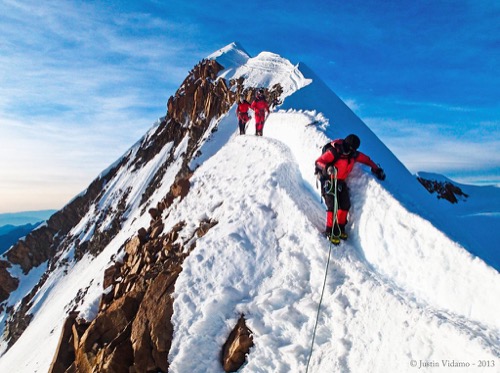
Read Next →
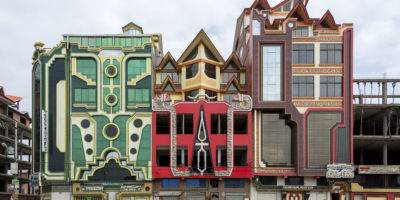
El Alto Cholets: Psychedelic Architecture In Bolivia
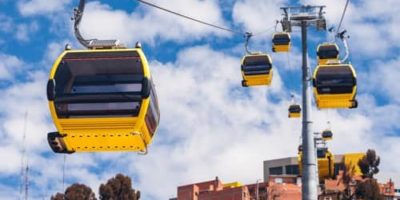
Dealing With Altitude Sickness in La Paz, Bolivia
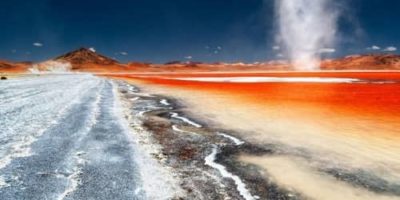
34 Best Bolivia Tourist Attractions
So you’re planning to climb Huayna Potosi? Most of my friends who visit me in La Paz ask how hard it is to climb Huayna Potosi. Here’s what I always tell them.
So is climbing Huayna Potosi hard? If you’re reasonably fit and well acclimatized, Huayna Potosi is one of the easiest 6000m+ peaks you can climb. Even if you don’t have any prior mountaineering experience, your guides will teach you the basics one day before the climb.
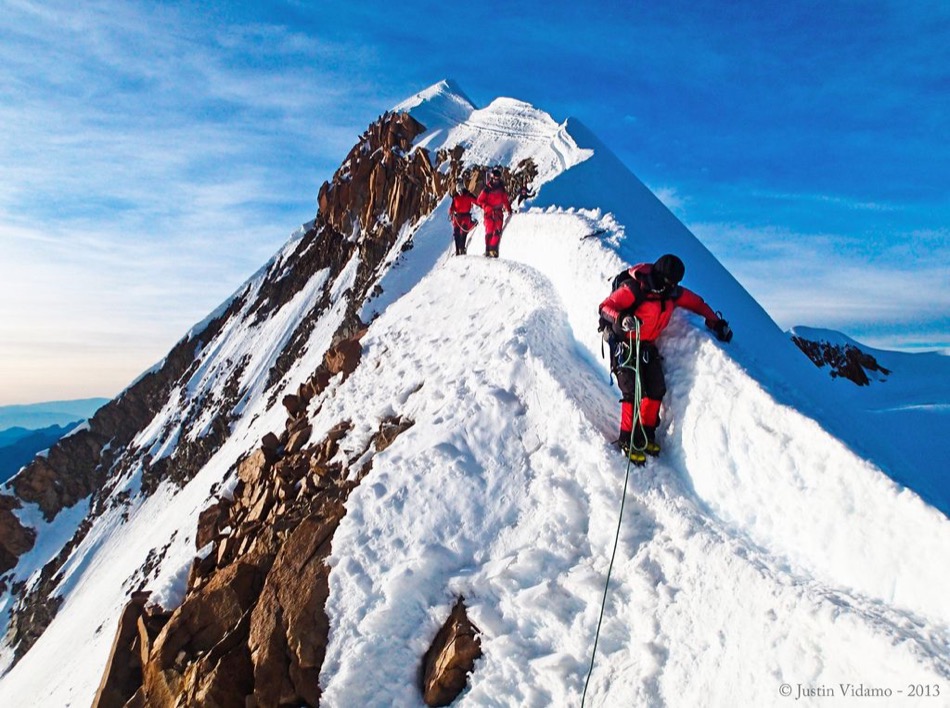
Although I’m not super fit, I’ve climbed Huayna Potosi three times with visiting friends. Read on and I’ll tel you how to prepare, what to expect and what challenges you might face.
How Long Does it Take to Climb Huayna Potosi?
In general, the Huayna Potosi trek is a 3 day itinerary. On the first day, you leave La Paz and settle down in the Zongo Pass base camp. In the afternoon, the guides will take you to practice the skills needed for the more technical parts of the climb.
The second day starts early in the morning. It takes 3-4 hours to reach the base camp from where you’ll make the final climb to the summit later tonight.
On the third day, you start the trek to the summit at 1AM. This is the most challenging day since the climb is done at a 45 degree angle on the east face of the mountain. It takes approximately 6 to 7 hours to make it to the top.
Here are the trails available on Huayna Potosi:
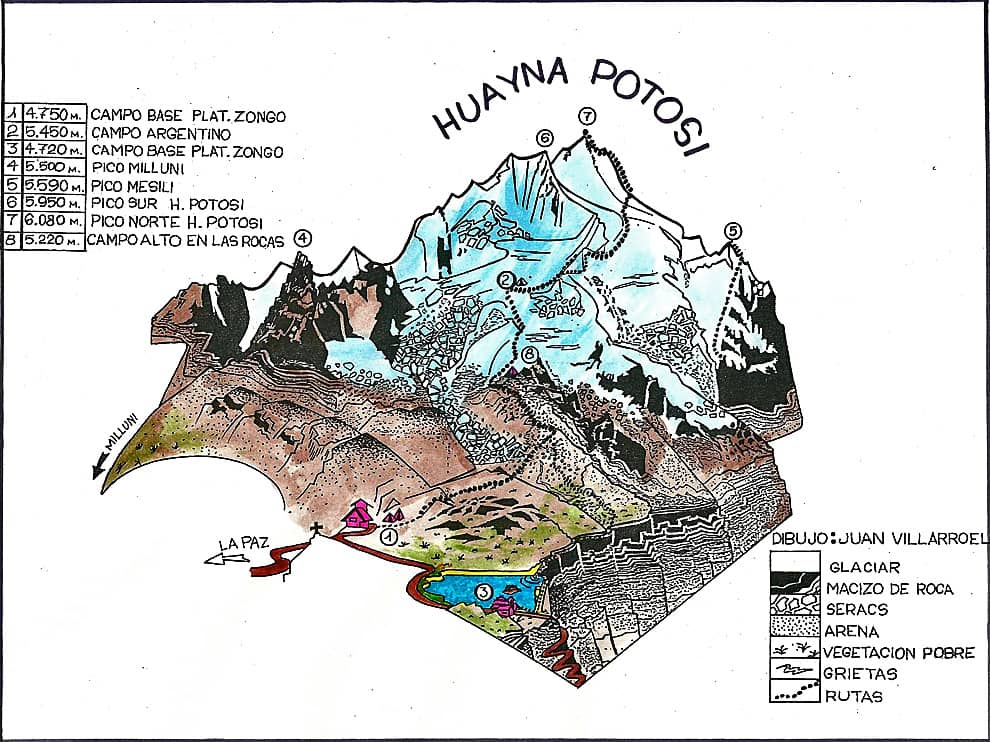
There are 3 trails to climb Huayna Potosi:
The Normal Route
The american route, the french route.
This is the most popular route to climb Huayna Potosi. Most agencies in La Paz offer this route since it’s the easiest of the three routes and suitable for beginners. You can expect to pay between 700 to 1000 BOB.
If this is your first time, you should take this route.
The American Route is also called the Lyon Route (no idea why). This route climbs the west face of the mountain. This route is not crowded and it’s likely that you’ll be the only one climbing on this route.
This is a more technical climb than the normal route and is suitable only for experienced climbers. In bad weather, it can take over 24 hours to climb the mountain.
The French Route is also a very technical climb. In addition, you need camping equipment including tents. Good fitness and prior mountaineering experience is a must.
Here is my post about whether Huayna Potosi is dangerous.
So Who Can Climb Huayna Potosi?
Like I said earlier, Huayna Potosi is the most beginner friendly 6000m+ mountain in Bolivia. That said, you do need to be reasonably fit and well acclimatized.
Although it’s not technically hard, the agencies in La Paz make it sound much easier than it is. Obviously, that’s because they’re tying to sell you tours. I cannot emphasize how important acclimatization is.
Make sure that you’ve spent at least 4 days in La Paz or another high altitude place before you attempt the climb to the summit.
On the last day, it’s more about mental strength than physical fitness. The climb isn’t very technical. So most of the people who don’t make it to the top either give up due to mental exhaustion, or suffer from altitude sickness.
Best Time To Climb Huayna Potosi
Although you can climb throughout the year, the best time for climbing the Huayna Potosi is between the months of June and September, when rainfall is minimal and the skies are fairly clear. However, you should be aware that the days are shorter and the temperatures can reach -20ºC.
Here are the average monthly temperatures in Huayna Potosi:
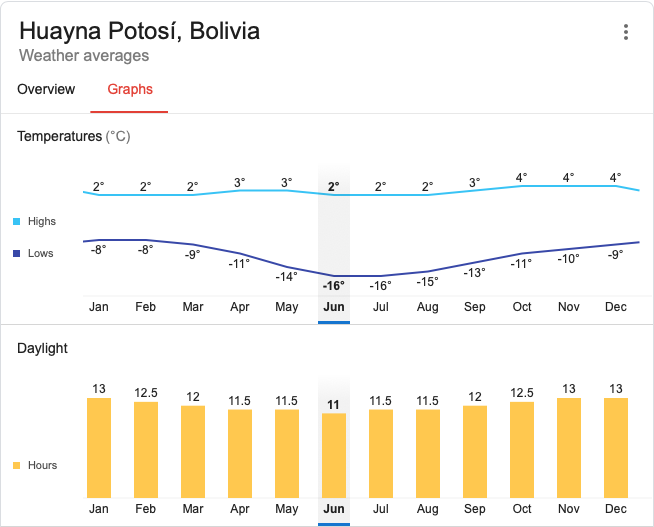
Preparing For The Climb
Check the weather.
Before you book your trip, check the weather forecast for the next few days. You’re probably going to attempt this only once. If the forecast is not good, I recommend postponing the departure.
Check Your Gear
At minimum, you’ll need breathable clothing, thermal clothing, gloves, a wool cap, boots, sunglasses. Also, ice axe and crampons. Some of these may be provided by your tour operator in La Paz. However, the gear they provide has seen better days. So I recommend getting your own gear.
Training course
If you have time before your trip, try and take a course in Alpine climbing. Various clubs offer introductory courses in which basic techniques are taught. This will help you be more confident during the actual climb.
Physical Fitness
Mountaineering requires good physical condition and endurance skills, as it is a demanding physical activity. Consistent physical preparation for at least 3 months before the ascent (hiking, biking, jogging) will make your climb much more enjoyable.
How Much Does It Cost To Climb Huayna Potosi?
Most 3 day / 2 night tours to climb Huayna Potosi cost around 700 BOB. They all include shared transportation, meals, climbing equipment, 2 nights in a refuge and a Spanish speaking guide. If you’d like an English speaking guide, you’ll have to pay a little extra.
Some additional expenses that you may have are expenses for additional equipment that won’t be provided (like sleeping bags, head lamps etc), the entrance ticket, fees to use the toilets, water and if you like, a porter.
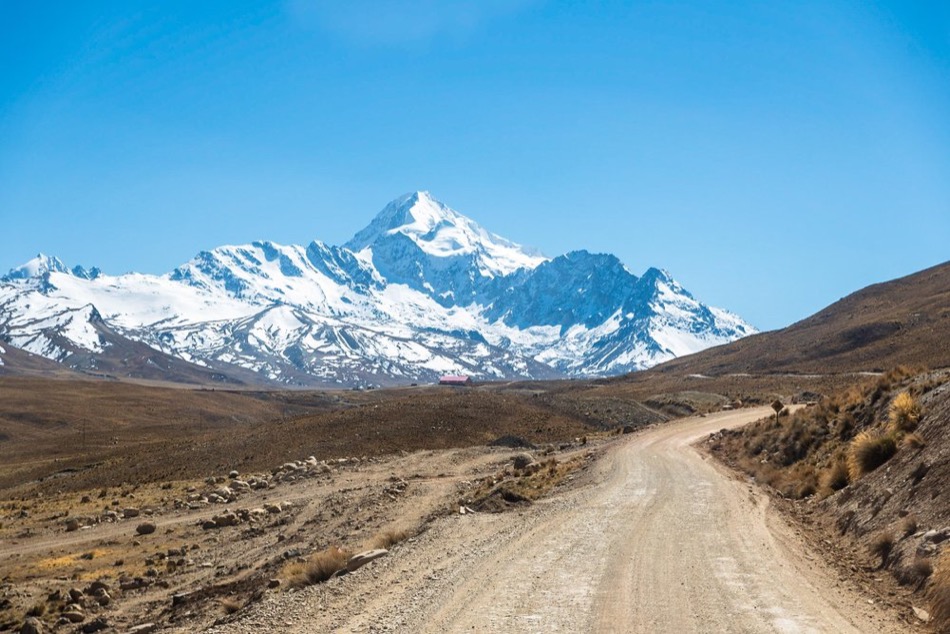
How To Get To Huayna Potosi
Generally, if you book a tour to Huayna Potosi, shared transportation from La Paz will be included in your package. However, if for any reason you decide to find your own way to the Zongo base camp, you can do it easily with public transport or your own car.
From the center of La Paz, head towards the north exit of the city. Once on route 41, proceed to Avenida Chacaltaya, where you should turn right. Advance along this route towards the North. 5.6 kilometers ahead of this intersection, there is a fork: to the right it leads to Chacaltaya, and to the left to Paso Zongo. There are 14.8 additional kilometers bordering several mountain lakes until you reach the beginning of the route, at the new Llaulini Refuge.
From PLaza Murillo (center of La Paz) it is 31.6 kilometers to the beginning of the hike. The traffic is normally heavy, so you should consider about an hour and twenty minutes of travel.
Public Transport
Bus: There are public buses (mini buses) to Zongo, with no fixed departure time. They leave as soon as they are full. To get to the bus stop, take the red cable car to La Paz Alto, which is the last stop of the red cable car.
Then you can walk or take a cab (5 bs) to the Plaza Ballivian and wait for the mini buses to Zongo (20 BOB). Make sure you get off at the Huayna Potosi base camp. The trip takes approximately one hour from El Alto.
Cab or private transportation: Taxis usually charge 100 bolivianos from La Paz to the base camp, but if you prefer security, use the services of a tourist agency (there are many in Sagarnaga street).
Sun Protection
You probably already know that altitude increases the risk of sunburn. For a long time it has been wrongly believed that the effect of the sun’s rays on the skin was greater at lower altitudes. But according to several studies it has been shown that the exact opposite is true: the higher the altitude of sun exposure, the greater the effects of the sun.
The higher you go, the faster you will get burned. It is estimated that for every 300 meters above sea level, the risk of suffering a burn increases by 4 to 5 percent. You go to over 6000m when you climb Huayna Potosi. In the snow, the risk of burns is even greater. The snow acts as a mirror that reflects the sun’s rays, so the body receives more radiation.
So how do you protect yourself? To begin with, you should use sunscreen with a higher protection factor (SPF) than the one usually used at the beach. You’ll also have to reapply the protection approximately every two hours.
Please take special care of the area around the eyes and lips which are more delicate than the rest. Use a lip balm with a high sun protection factor, especially in the snow. I recommend buying these products before you arrive in Bolivia. You’ll probably have a better choice.
Don’t forget to protect your eyes with good quality sunglasses. And don’t forget to cover your head with a hat or cap to avoid getting sunburned.
Massimo Hernandes
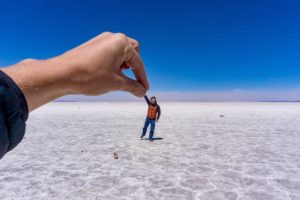
My name is Massimo, and I was born in La Paz, Bolivia.
From Cochabamba to Potosi, Sucre, and of course, La Paz, I’ve seen everything that these major destinations have to offer and met friends everywhere in between. Through this blog, I hope to share some of my adventures, good eats, and unique experiences with you.

Post comment
or continue as guest

40 Facts About Elektrostal
Written by Lanette Mayes
Modified & Updated: 01 Jun 2024
Reviewed by Jessica Corbett

Elektrostal is a vibrant city located in the Moscow Oblast region of Russia. With a rich history, stunning architecture, and a thriving community, Elektrostal is a city that has much to offer. Whether you are a history buff, nature enthusiast, or simply curious about different cultures, Elektrostal is sure to captivate you.
This article will provide you with 40 fascinating facts about Elektrostal, giving you a better understanding of why this city is worth exploring. From its origins as an industrial hub to its modern-day charm, we will delve into the various aspects that make Elektrostal a unique and must-visit destination.
So, join us as we uncover the hidden treasures of Elektrostal and discover what makes this city a true gem in the heart of Russia.
Key Takeaways:
- Elektrostal, known as the “Motor City of Russia,” is a vibrant and growing city with a rich industrial history, offering diverse cultural experiences and a strong commitment to environmental sustainability.
- With its convenient location near Moscow, Elektrostal provides a picturesque landscape, vibrant nightlife, and a range of recreational activities, making it an ideal destination for residents and visitors alike.
Known as the “Motor City of Russia.”
Elektrostal, a city located in the Moscow Oblast region of Russia, earned the nickname “Motor City” due to its significant involvement in the automotive industry.
Home to the Elektrostal Metallurgical Plant.
Elektrostal is renowned for its metallurgical plant, which has been producing high-quality steel and alloys since its establishment in 1916.
Boasts a rich industrial heritage.
Elektrostal has a long history of industrial development, contributing to the growth and progress of the region.
Founded in 1916.
The city of Elektrostal was founded in 1916 as a result of the construction of the Elektrostal Metallurgical Plant.
Located approximately 50 kilometers east of Moscow.
Elektrostal is situated in close proximity to the Russian capital, making it easily accessible for both residents and visitors.
Known for its vibrant cultural scene.
Elektrostal is home to several cultural institutions, including museums, theaters, and art galleries that showcase the city’s rich artistic heritage.
A popular destination for nature lovers.
Surrounded by picturesque landscapes and forests, Elektrostal offers ample opportunities for outdoor activities such as hiking, camping, and birdwatching.
Hosts the annual Elektrostal City Day celebrations.
Every year, Elektrostal organizes festive events and activities to celebrate its founding, bringing together residents and visitors in a spirit of unity and joy.
Has a population of approximately 160,000 people.
Elektrostal is home to a diverse and vibrant community of around 160,000 residents, contributing to its dynamic atmosphere.
Boasts excellent education facilities.
The city is known for its well-established educational institutions, providing quality education to students of all ages.
A center for scientific research and innovation.
Elektrostal serves as an important hub for scientific research, particularly in the fields of metallurgy , materials science, and engineering.
Surrounded by picturesque lakes.
The city is blessed with numerous beautiful lakes , offering scenic views and recreational opportunities for locals and visitors alike.
Well-connected transportation system.
Elektrostal benefits from an efficient transportation network, including highways, railways, and public transportation options, ensuring convenient travel within and beyond the city.
Famous for its traditional Russian cuisine.
Food enthusiasts can indulge in authentic Russian dishes at numerous restaurants and cafes scattered throughout Elektrostal.
Home to notable architectural landmarks.
Elektrostal boasts impressive architecture, including the Church of the Transfiguration of the Lord and the Elektrostal Palace of Culture.
Offers a wide range of recreational facilities.
Residents and visitors can enjoy various recreational activities, such as sports complexes, swimming pools, and fitness centers, enhancing the overall quality of life.
Provides a high standard of healthcare.
Elektrostal is equipped with modern medical facilities, ensuring residents have access to quality healthcare services.
Home to the Elektrostal History Museum.
The Elektrostal History Museum showcases the city’s fascinating past through exhibitions and displays.
A hub for sports enthusiasts.
Elektrostal is passionate about sports, with numerous stadiums, arenas, and sports clubs offering opportunities for athletes and spectators.
Celebrates diverse cultural festivals.
Throughout the year, Elektrostal hosts a variety of cultural festivals, celebrating different ethnicities, traditions, and art forms.
Electric power played a significant role in its early development.
Elektrostal owes its name and initial growth to the establishment of electric power stations and the utilization of electricity in the industrial sector.
Boasts a thriving economy.
The city’s strong industrial base, coupled with its strategic location near Moscow, has contributed to Elektrostal’s prosperous economic status.
Houses the Elektrostal Drama Theater.
The Elektrostal Drama Theater is a cultural centerpiece, attracting theater enthusiasts from far and wide.
Popular destination for winter sports.
Elektrostal’s proximity to ski resorts and winter sport facilities makes it a favorite destination for skiing, snowboarding, and other winter activities.
Promotes environmental sustainability.
Elektrostal prioritizes environmental protection and sustainability, implementing initiatives to reduce pollution and preserve natural resources.
Home to renowned educational institutions.
Elektrostal is known for its prestigious schools and universities, offering a wide range of academic programs to students.
Committed to cultural preservation.
The city values its cultural heritage and takes active steps to preserve and promote traditional customs, crafts, and arts.
Hosts an annual International Film Festival.
The Elektrostal International Film Festival attracts filmmakers and cinema enthusiasts from around the world, showcasing a diverse range of films.
Encourages entrepreneurship and innovation.
Elektrostal supports aspiring entrepreneurs and fosters a culture of innovation, providing opportunities for startups and business development .
Offers a range of housing options.
Elektrostal provides diverse housing options, including apartments, houses, and residential complexes, catering to different lifestyles and budgets.
Home to notable sports teams.
Elektrostal is proud of its sports legacy , with several successful sports teams competing at regional and national levels.
Boasts a vibrant nightlife scene.
Residents and visitors can enjoy a lively nightlife in Elektrostal, with numerous bars, clubs, and entertainment venues.
Promotes cultural exchange and international relations.
Elektrostal actively engages in international partnerships, cultural exchanges, and diplomatic collaborations to foster global connections.
Surrounded by beautiful nature reserves.
Nearby nature reserves, such as the Barybino Forest and Luchinskoye Lake, offer opportunities for nature enthusiasts to explore and appreciate the region’s biodiversity.
Commemorates historical events.
The city pays tribute to significant historical events through memorials, monuments, and exhibitions, ensuring the preservation of collective memory.
Promotes sports and youth development.
Elektrostal invests in sports infrastructure and programs to encourage youth participation, health, and physical fitness.
Hosts annual cultural and artistic festivals.
Throughout the year, Elektrostal celebrates its cultural diversity through festivals dedicated to music, dance, art, and theater.
Provides a picturesque landscape for photography enthusiasts.
The city’s scenic beauty, architectural landmarks, and natural surroundings make it a paradise for photographers.
Connects to Moscow via a direct train line.
The convenient train connection between Elektrostal and Moscow makes commuting between the two cities effortless.
A city with a bright future.
Elektrostal continues to grow and develop, aiming to become a model city in terms of infrastructure, sustainability, and quality of life for its residents.
In conclusion, Elektrostal is a fascinating city with a rich history and a vibrant present. From its origins as a center of steel production to its modern-day status as a hub for education and industry, Elektrostal has plenty to offer both residents and visitors. With its beautiful parks, cultural attractions, and proximity to Moscow, there is no shortage of things to see and do in this dynamic city. Whether you’re interested in exploring its historical landmarks, enjoying outdoor activities, or immersing yourself in the local culture, Elektrostal has something for everyone. So, next time you find yourself in the Moscow region, don’t miss the opportunity to discover the hidden gems of Elektrostal.
Q: What is the population of Elektrostal?
A: As of the latest data, the population of Elektrostal is approximately XXXX.
Q: How far is Elektrostal from Moscow?
A: Elektrostal is located approximately XX kilometers away from Moscow.
Q: Are there any famous landmarks in Elektrostal?
A: Yes, Elektrostal is home to several notable landmarks, including XXXX and XXXX.
Q: What industries are prominent in Elektrostal?
A: Elektrostal is known for its steel production industry and is also a center for engineering and manufacturing.
Q: Are there any universities or educational institutions in Elektrostal?
A: Yes, Elektrostal is home to XXXX University and several other educational institutions.
Q: What are some popular outdoor activities in Elektrostal?
A: Elektrostal offers several outdoor activities, such as hiking, cycling, and picnicking in its beautiful parks.
Q: Is Elektrostal well-connected in terms of transportation?
A: Yes, Elektrostal has good transportation links, including trains and buses, making it easily accessible from nearby cities.
Q: Are there any annual events or festivals in Elektrostal?
A: Yes, Elektrostal hosts various events and festivals throughout the year, including XXXX and XXXX.
Elektrostal's fascinating history, vibrant culture, and promising future make it a city worth exploring. For more captivating facts about cities around the world, discover the unique characteristics that define each city . Uncover the hidden gems of Moscow Oblast through our in-depth look at Kolomna. Lastly, dive into the rich industrial heritage of Teesside, a thriving industrial center with its own story to tell.
Was this page helpful?
Our commitment to delivering trustworthy and engaging content is at the heart of what we do. Each fact on our site is contributed by real users like you, bringing a wealth of diverse insights and information. To ensure the highest standards of accuracy and reliability, our dedicated editors meticulously review each submission. This process guarantees that the facts we share are not only fascinating but also credible. Trust in our commitment to quality and authenticity as you explore and learn with us.
Share this Fact:

IMAGES
COMMENTS
Day 3: High Camp (5,200m) - Huayna Potosi Summit (6,088m) - Base Camp - La Paz. Day 3 is the most challenging: the summit climb. You'll start your trek at 1 am and continue for 6 hours to the summit. Your harness will be attached to your guide and climbing buddy for safety reasons. The first 5 hours are in the dark.
Just like Huayna Potosi, the Condoriri massif stands close to La Paz, to the north-east of Huayna Potosi, and goes as high as 5.648 above sea level. Many trekkers choose to combine both peaks in one trek since they are relatively close and the Condodiriri is a nice warm-up before the trek to the summit of Huayna Potosi.
We spent 8 days hiking in Bolivia and finished our trek by climbing Huayna Potosi. The 125km Andean mountain range rises to the southeast of Lake Titicaca and some of its glaciated peaks can be seen from Bolivia's exciting capital La Paz. If you're looking for some high altitude fun without the crowds seen in other parts of South America ...
Huayna Potosi is one of a handful of peaks that reaches over 6000 meters in the Cordillera Real. The Cordillera Real is a mountain range in eastern Bolivia and a sub-range of the Andes. The closest mountain to the city of La Paz, Huayna Potosi, is a bumpy and winding forty-kilometer drive north of Bolivia's capital.
In fact, Huayna Potosi is the most climbed mountain in the Cordillera Real and around La Paz. Its proximity to La Paz, its PD normal route, the presence of refuges and, most importantly, the huge amount of advertisement in tour agencies in La Paz initiate plenty of outdoor enthusiasts into mountaineering, while its other routes including its West face will offer different environments for more ...
DAY 3. High Camp to Summit to La Paz. Elevation (ft): 16,896 ft. to 19,947 ft. Hiking Time: 9-13 hours. We have an early morning start around midnight as we head up the glacier. It will be cold and dark, and the ascent will take approximately 6 hours. The climb mostly follows a trail on the glacier with two steep sections; the first is called ...
Huayna Potosí Mountain. Head out on this 6.4-mile out-and-back trail near La Paz, La Paz. Generally considered a challenging route. This is a very popular area for backpacking, hiking, and rock climbing, so you'll likely encounter other people while exploring. The best times to visit this trail are September through September.
Annotated topo map. This is by far the most popular route up Huayna Potosi, the one that is sold in every mountaineering agency in La Paz. During the high season, dozens of climbers will climb, walk, crawl or even get hauled by their guide up this route, most of which for whom this will be their first mountaineering experience.
The trek from Chacaltaya to Huayna Potosí is a short but challenging high-altitude trail in Bolivia. It is important to be well acclimated to the altitude, as all of the trek is above 4500 meters. This trek serves as good altitude training for those planning to climb Huayna Potosi in the future.
Summit the Huayna Potosi in the northeast of La Paz, one of the easiest 6000m mountains to climb in the world and deservedly one of Bolivia's most popular climbs. A complete beginners trek with amazing, magnificent views of the Cordillera Real, Lake Titikaka, and the Altiplano, this is a trek to not miss!
Day 2. Short trek from Base Camp to High Camp (5,150), approximately 2-3 hours. Day 3. Early departure from the high camp to the summit (6,088m) and return to your hotel in the city of La Paz. Climbing Huayna Potosi 6,088m. The most popular mountains in Bolivia, this mountain has two main routes, the most affordable 6000.
The Huayna Potosí Trek is a 5.4 km trail that starts in La Paz, Pedro Domingo Murillo, Bolivia. Based on our data, the trail is graded as Extra Difficult. For information on how we grade trails, please read measuring the difficulty of a hiking trail on hiiker. Also, check our latest community posts for trail updates.
A few weeks ago Andean Trails' customers Sarah and Richard returned from a 3-day trek to summit Huayna Potosi. The summit provided great views of La Paz, El Alto, Illimani, Mururata, the Amazon Basin, Condoriri, the Cordillera Real, the Altiplano (4000m) and Lake Titicaca. Sarah said: "Our trek on Huayna Potosi was amazing.
Today is a short hike of only 3 hours. We climb to Huallatani (4850m), the last pass of our trek, and then descend to Huayna Potosi's base camp (4700m) where we will have our last lunch in the mountains before driving back to La Paz. Private transport. Bilingual tour guide (Spanish- English) Food during the expedition.
> Trek over a glacier > Spend your night in the Refugio at High Camp. Bolivia´s Most Popular climb Huayna Potosi (6088m) is northeast of La Paz in the Cordillera Real and is known as one of the easiest 6000m plus mountains to climb in the world.
Climb Huayna Potosi in Bolivia, the perfect Andean mountain for novice or experienced mountaineers. Huayna Potosi, despite its mighty 6,088m/19,974ft, is a straightforward climb and a great challenge for anyone looking to end a trek in style. The summit provides amazing views of La Paz, El Alto, Illimani, Mururata, the Amazon…
Condoriri trek & Huayna Potosi Climb. This program combines 2 ½ days of trekking through the Cordillera Real, an afternoon of basic mountaineering instruction and practice, and a 2 day climbing of Huayna Potosi (6088 meters) at La Paz - Bolivia. Our trek begins in the scenic Condoriri region of lakes and glaciated peaks and includes the ...
Huayna Potosi 6,088m Bolivia — The Trek Blog. Huayna Potosi was our second acclimatization step on the road to Ancohuma. You will see the name "Huayna Potosi" on the window of every agency in La Paz offering a 3 day climb to a 6,000m mountain for novices. It is a surprisingly beautiful experience.
How Long Does it Take to Climb Huayna Potosi? In general, the Huayna Potosi trek is a 3 day itinerary. On the first day, you leave La Paz and settle down in the Zongo Pass base camp. In the afternoon, the guides will take you to practice the skills needed for the more technical parts of the climb. The second day starts early in the morning.
A residential and industrial region in the south-east of Mocsow. It was founded on the spot of two villages: Chagino (what is now the Moscow Oil Refinery) and Ryazantsevo (demolished in 1979). in 1960 the town was incorporated into the City of Moscow as a district. Population - 45,000 people (2002). The district is one of the most polluted residential areas in Moscow, due to the Moscow Oil ...
596K subscribers in the vexillology community. A subreddit for those who enjoy learning about flags, their place in society past and present, and…
In 1938, it was granted town status. [citation needed]Administrative and municipal status. Within the framework of administrative divisions, it is incorporated as Elektrostal City Under Oblast Jurisdiction—an administrative unit with the status equal to that of the districts. As a municipal division, Elektrostal City Under Oblast Jurisdiction is incorporated as Elektrostal Urban Okrug.
40 Facts About Elektrostal. Elektrostal is a vibrant city located in the Moscow Oblast region of Russia. With a rich history, stunning architecture, and a thriving community, Elektrostal is a city that has much to offer. Whether you are a history buff, nature enthusiast, or simply curious about different cultures, Elektrostal is sure to ...